
We tried the Orphek Blue Plus in OR2 version and we were very curious to test the new OR3 version to see how they’ve been updated.
Many parts of this review are identical, or pretty similar, to the other OR3 bars, because the ceiling lights are absolutely identical.
We were very excited to test the ceiling light and to compare it with the other OR3s at our disposal, that are the Blue Sky, the Reef Day Plus, the UV/Violet (italian), and obviously the Blue Plus in OR2 version. Since we could test them all in a close time we can show them in detail, otherwise we’d have to bombard you with numbers.
The bars are beautiful, solid and they seem very well built, as the other OR3 – in fact, the shell between the bars is identical. Now Orphek has finally made a dimmer available, which allows us to dim the lights while they turn on and off, without distinguishing between channels. We were very excited about the dimmer, because it might be the only thing that was lacking in these ceiling lights. Even though, as you know, the dimmer is less important for bars than for actual ceiling lights. But we’ll talk about that later.
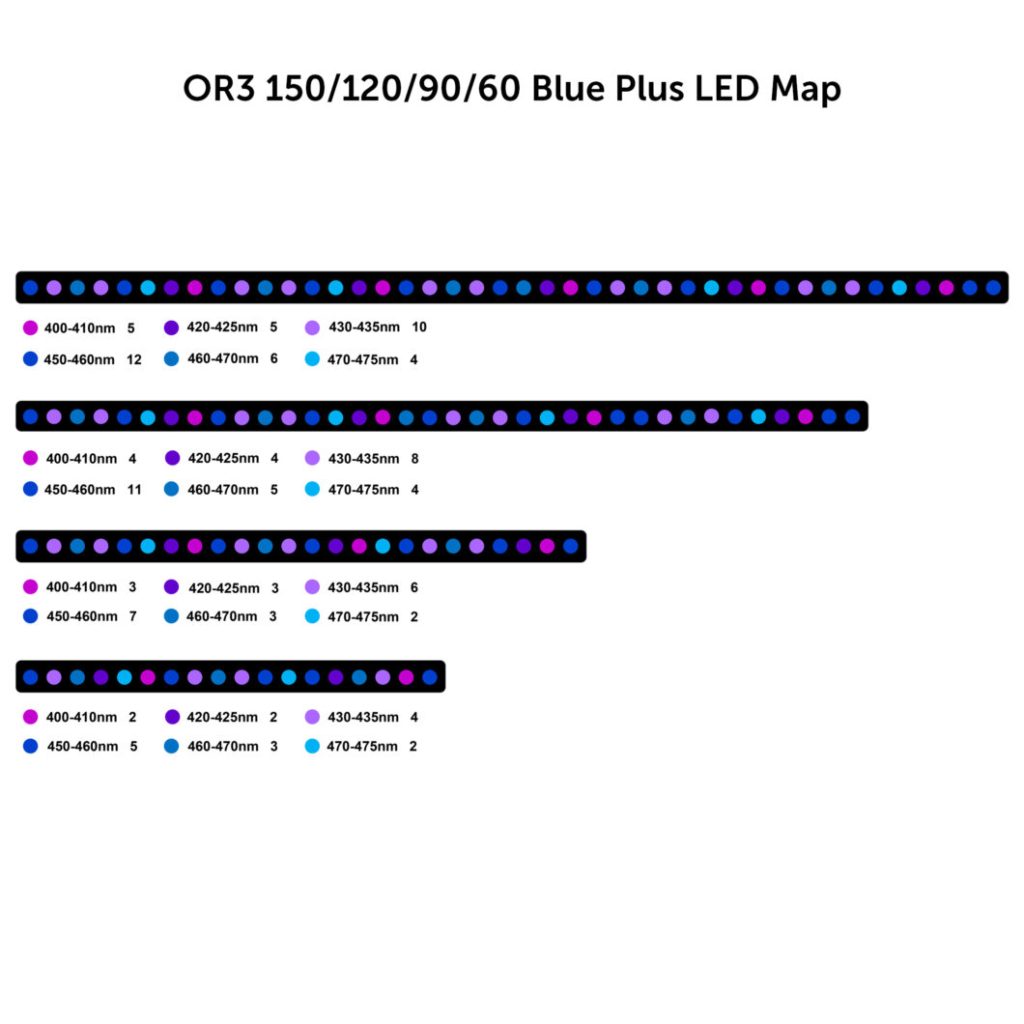
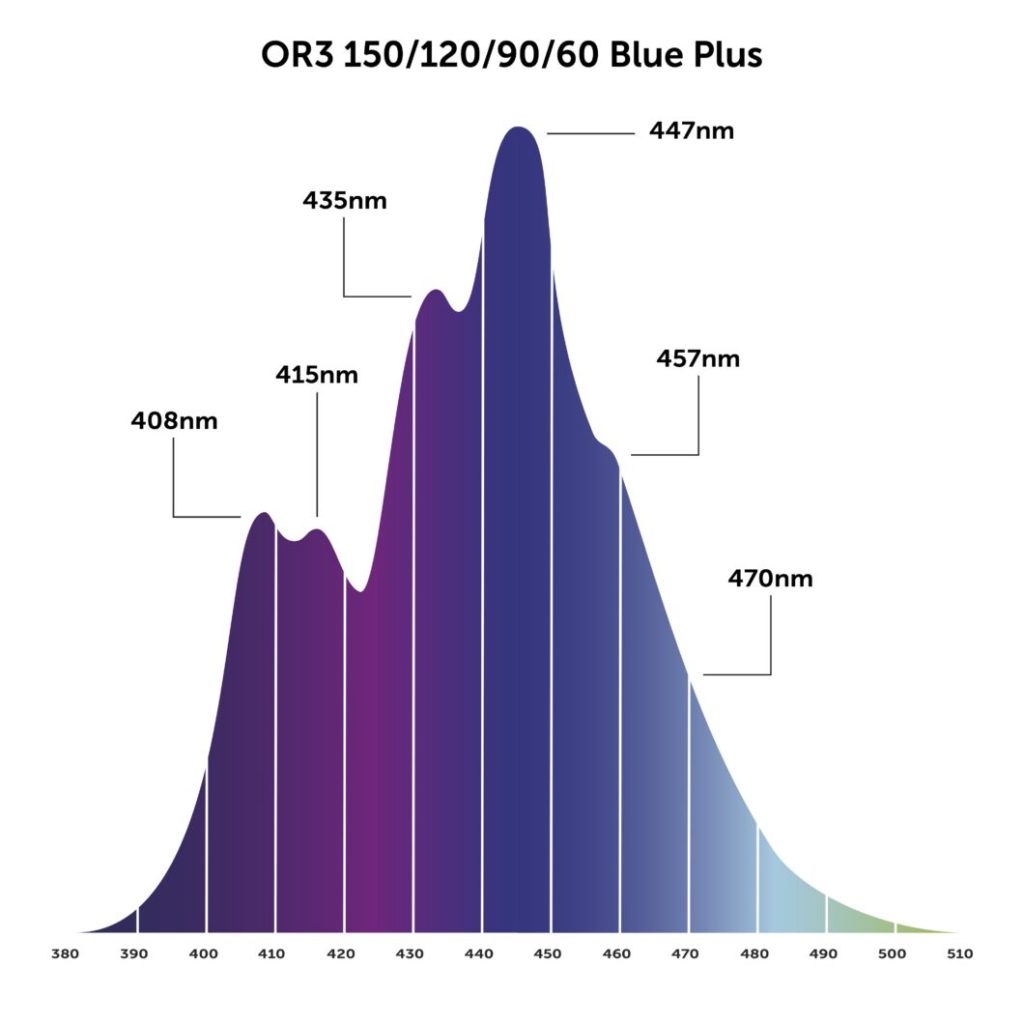
Technical characteristics of the Orphek OR3 Blue Plus LED bars
- Driver: external;
- Input Voltage: 100-240VAC;
- Frequency: 50-60Hz;
- Power consumption: 60 watts +-5%;
- Cos(phi) > 0.9;
- Input current (Amps) 0.55;
- Length: 123,5 cm;
- Width: 5 cm;
- Height: 3,6 cm;
- Weight: 2,3 kg;
- LEDs: 4×400/410nm, 4×420/425nm, 8×430/435nm, 11×450/460nm, 5×460/470nm, 4×470/475nm.
- Price to the public: 280 euro the 120 cm version.
The peculiarities of the Orphek OR3 Blue Plus
The new LED bars of the very lucky OR3 series comes with LEDs of 400 to 500 nanometers. The ceiling light is openly blue/violet, with a broader fluorescent spectrum. We really liked the OR2 Blue Plus, which is still for sale, as you can read in our DaniReef LAB (here). But Orphek, continuing with the studies on corals and reefs, as well as on our aquariums, affirmed that these new versions are a evolutionary step into the future, especially for the return with corals and their fluorescence.
As Orphek itself says: “Corals and anemones have at least two kinds of color compounds: fluorescent and non fluorescent. Fluorescence happens when a compound absorbs lights and emits it (fluorescent) at a longer wave length, so the fluorescent compounds light up (or “burst”) under the UV light, violet or blue, while the non fluorescent compounds don’t. In fact, they appear opaque under those wave lengths called cromoproteins. However, they all are proteins produced by the coral or the anemone“.
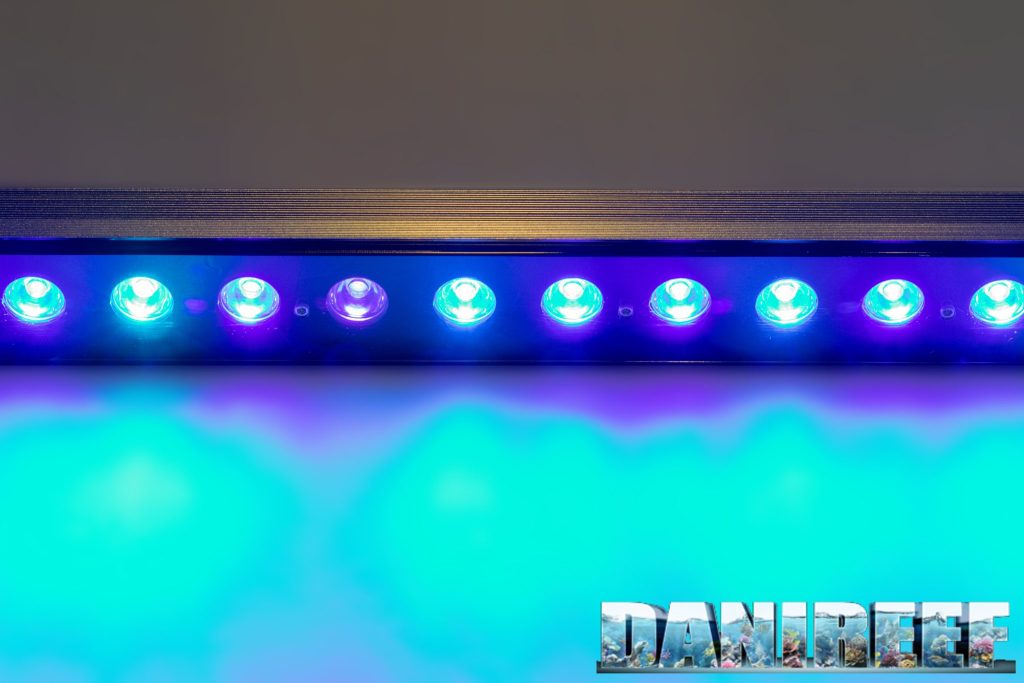
The suspension kit
The bars are sold with a suspension kit, which is pretty short to be fair, so, if you’re planning to hang them to the ceiling, you should also buy an extension. This kit is designed for Orphek‘s suspension arms. We’ve already said this, but again, the Orphek OR3 is very well built. The external refinement works as passive heatsink and, given the weight and the volume of the aluminum, we’re sure that these LED bars won’t have any problem with overheating. And the assembly is basically perfect.
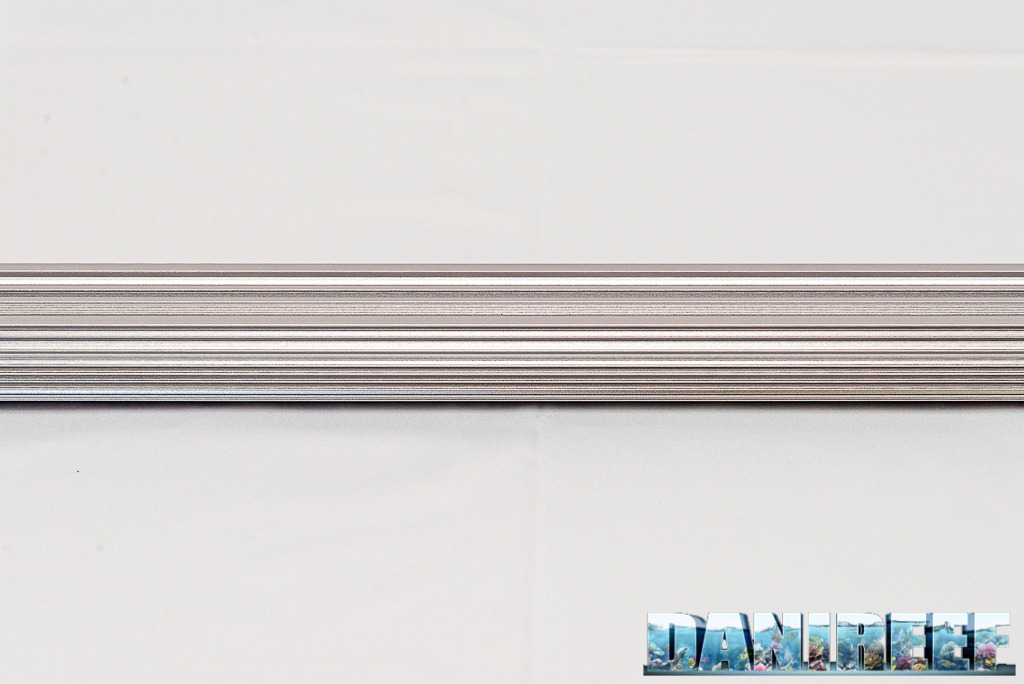
The Programming
LED bars generally can’t be programmed, and the Orphek OR3 isn’t an exception, at least for now. Some competitors’ bars provide equipment with a controller for dimming, or at least it can be bought singularly. Orphek has long announced the release of their own dimmable equipment, and we’re testing it now for you! Soon you’ll read the article about this long-awaited Osix. But with LED bars in general, I think the problem is relative. The spectrum has to be decided based on the bars that you want to couple and you can make a sort of dimming by switching on a bar at time. Let’s be clear, I’m not saying that dimming isn’t important, but when you use ceiling lights the lack is far more noticeable.
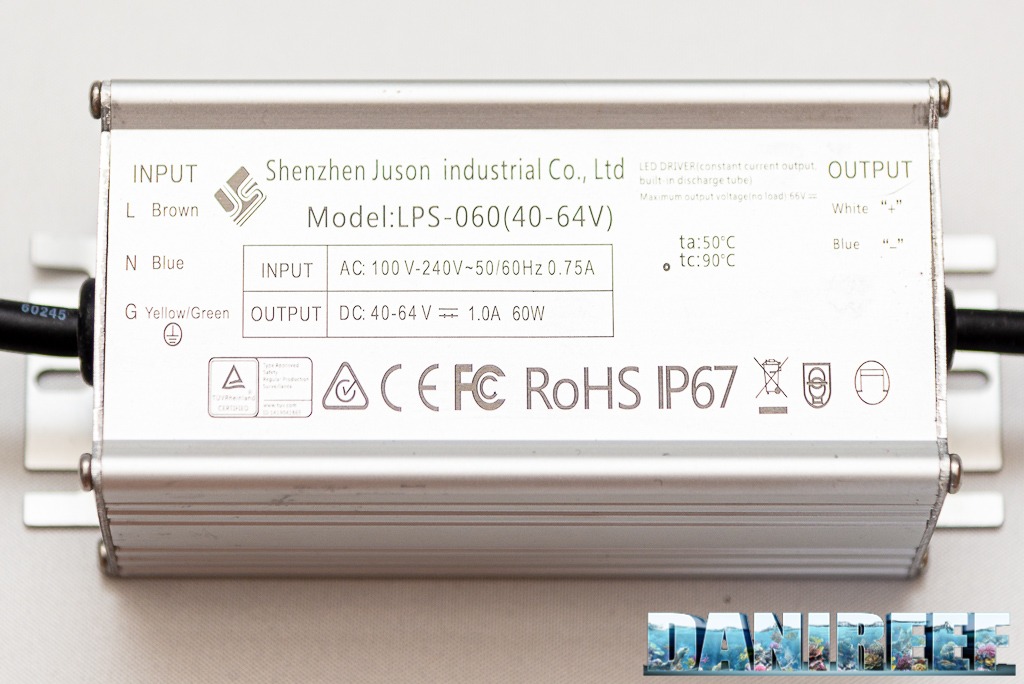
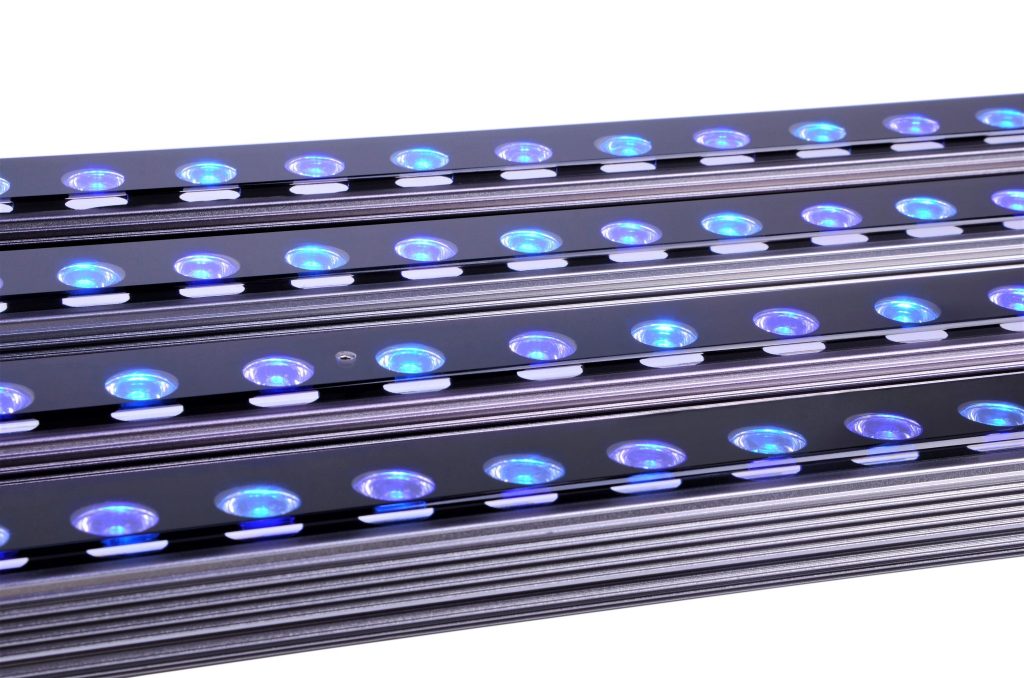
Different from usual we can’t give you consumption and values of each LED singularly, because these bars switch on all the LED simultaneously.
Our new DaniReef LAB for PAR measurement method
During the long nights spent on our forum we always wondered how we could compare PAR from different ceiling lights. Even though we had the perfect device, the Quantum Meter MQ-510 di Apogee, we always referred only to the value measured at the center at 20 cm of distance, more or less.
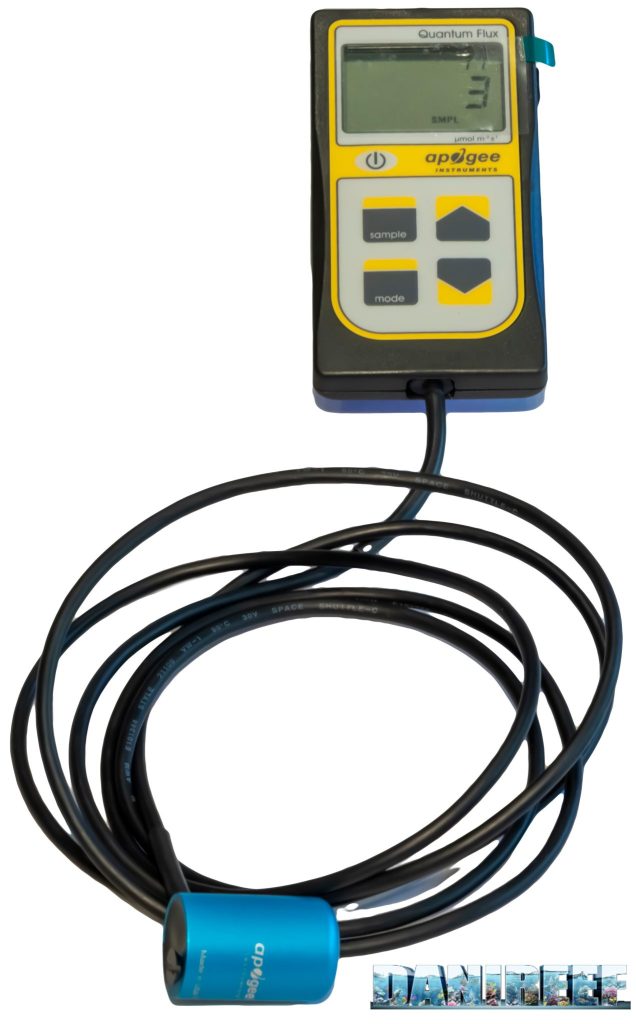
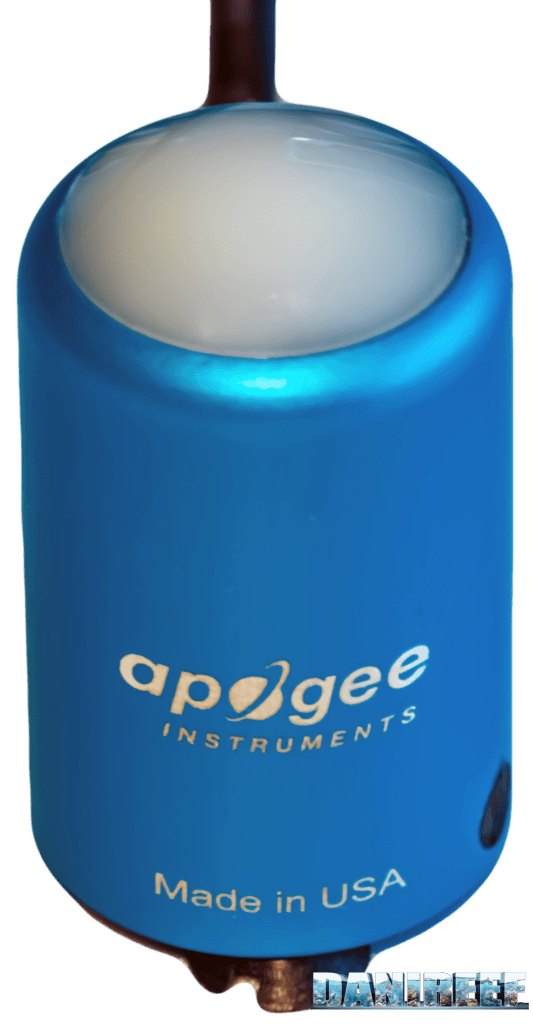
The Quantum Meter MQ-510 measures the PAR, expressed in PFFD, the photosynthetic photon flux density, in μmol m-2 s-1. This device is calibrated to work underwater, so if it’s in air the measured value has to be divided by 1,32 – the dive factor. We have to do the conversion. The values you’re going to see are correct.
We decided to make a square base of 70×70 cm, we set 25 fiducial points where we placed the sensor Quantum Meter MQ-510 and we also made 3 lifts of 20, 40 and 60 cm for the ceiling light, in order to have the same distance from the sensor. This will allow us to create the curves which can be compared to other ceiling lights’, all tested at the same distances. Notice that this distance is measured between the base of the sensor and the ceiling light. In reality it should be decreased by 3,5 cm which is the height of the measurement cylinder and increased by 0,5 cm which is the dimension of the spacers that lift the ceiling light.
In total the three measurements are made from 17, 37 and 57 cm of distance. Because they’ve been done in air they will be corrected.
PAR measurement from 17 cm of distance
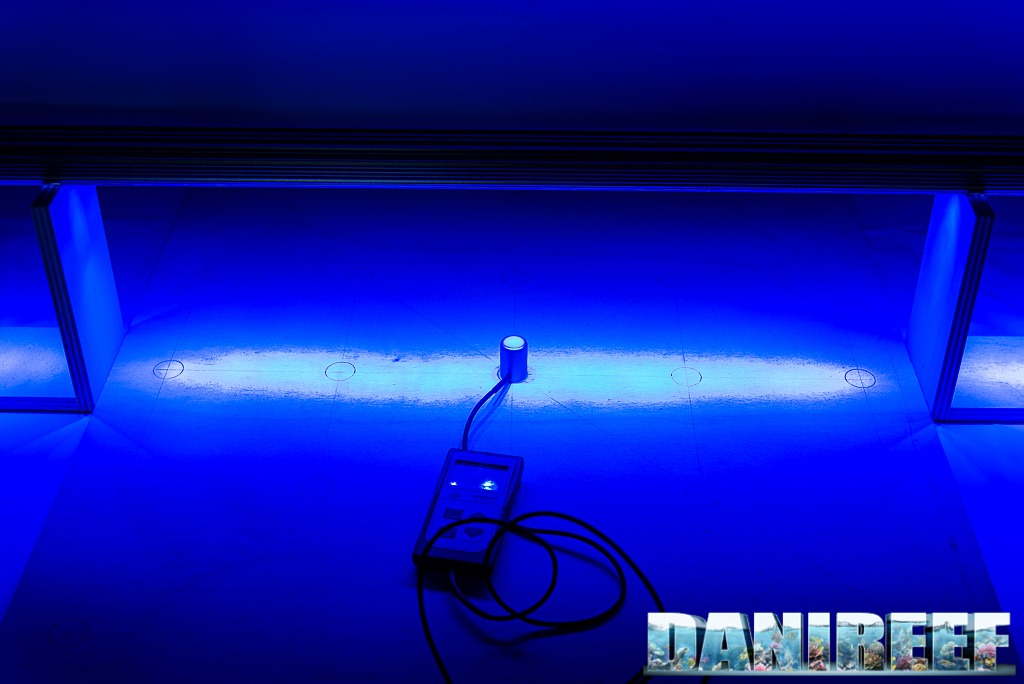
This is the condition of the test. Below there are the chart and the device, above you can glimpse the bar (in this case it was a OR3 Blue Sky) placed on the spacers.
These are the values:
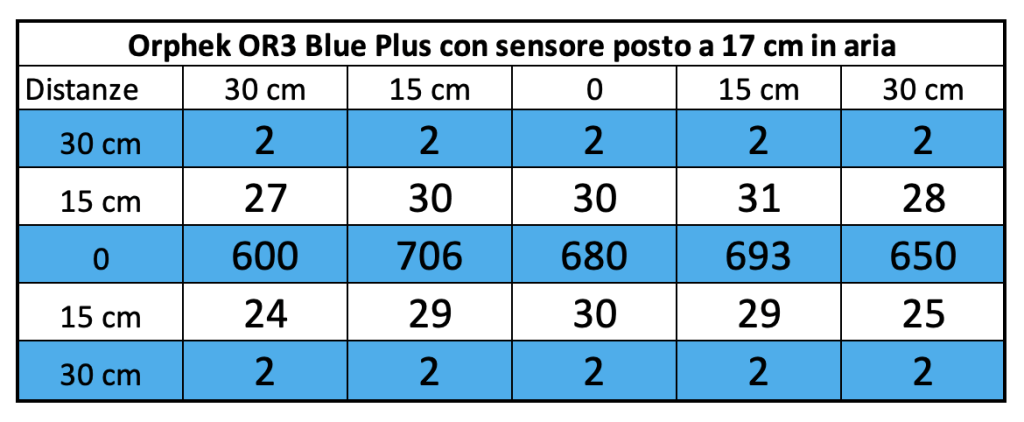
And that’s the corresponding chart, we came back to our classic scale in order to compare similar ceiling lights, but being this LED bars we lowered the maximum scale. For the future bars you will find the same evaluation scale.
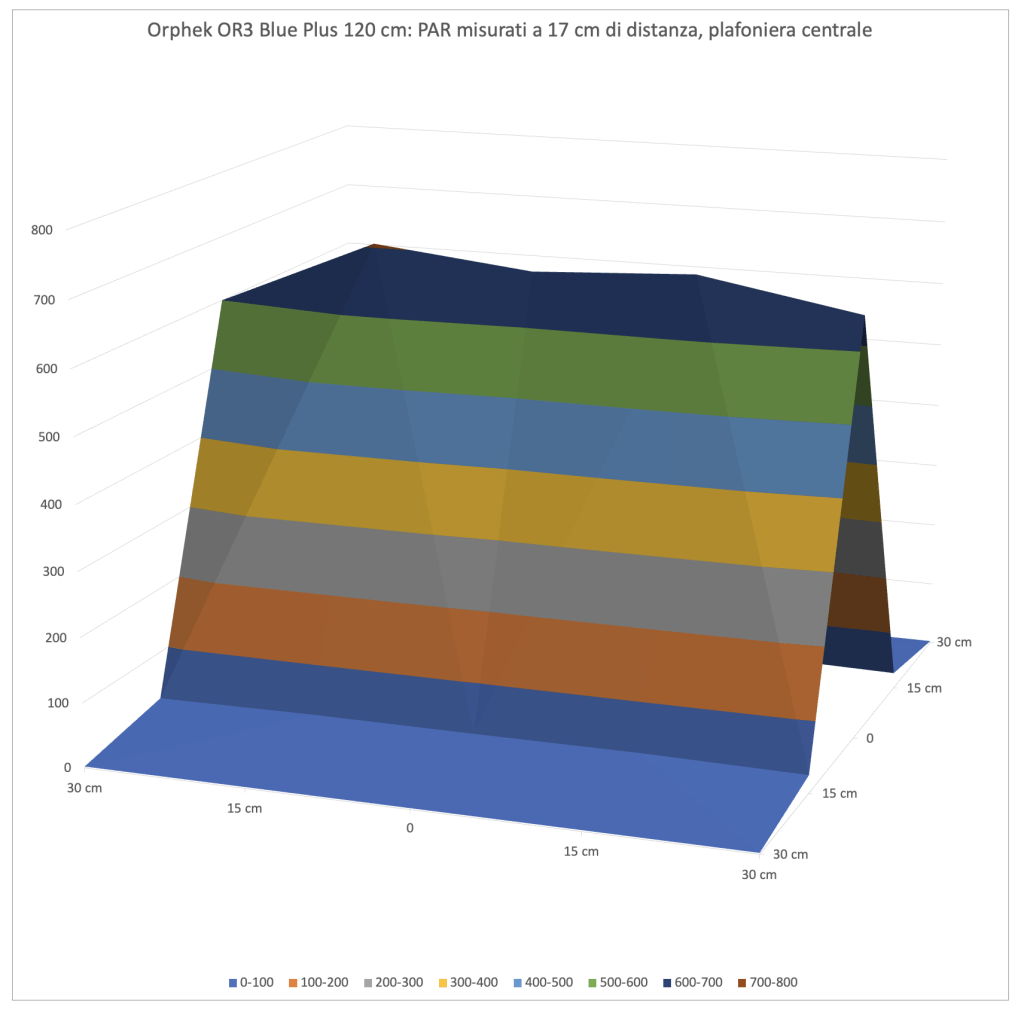
As you can see the bar creates a curve that resembles a tent, with the space differences due to the kind of used LED. Unlike the classic ceiling lights the decay is very linear, at 20 cm from the light source.
Let’s see the differences between the charts of the LED bars we’ve tested and, of course, the old OR2 Blue Plus. Remember that the evaluation scale is the same.
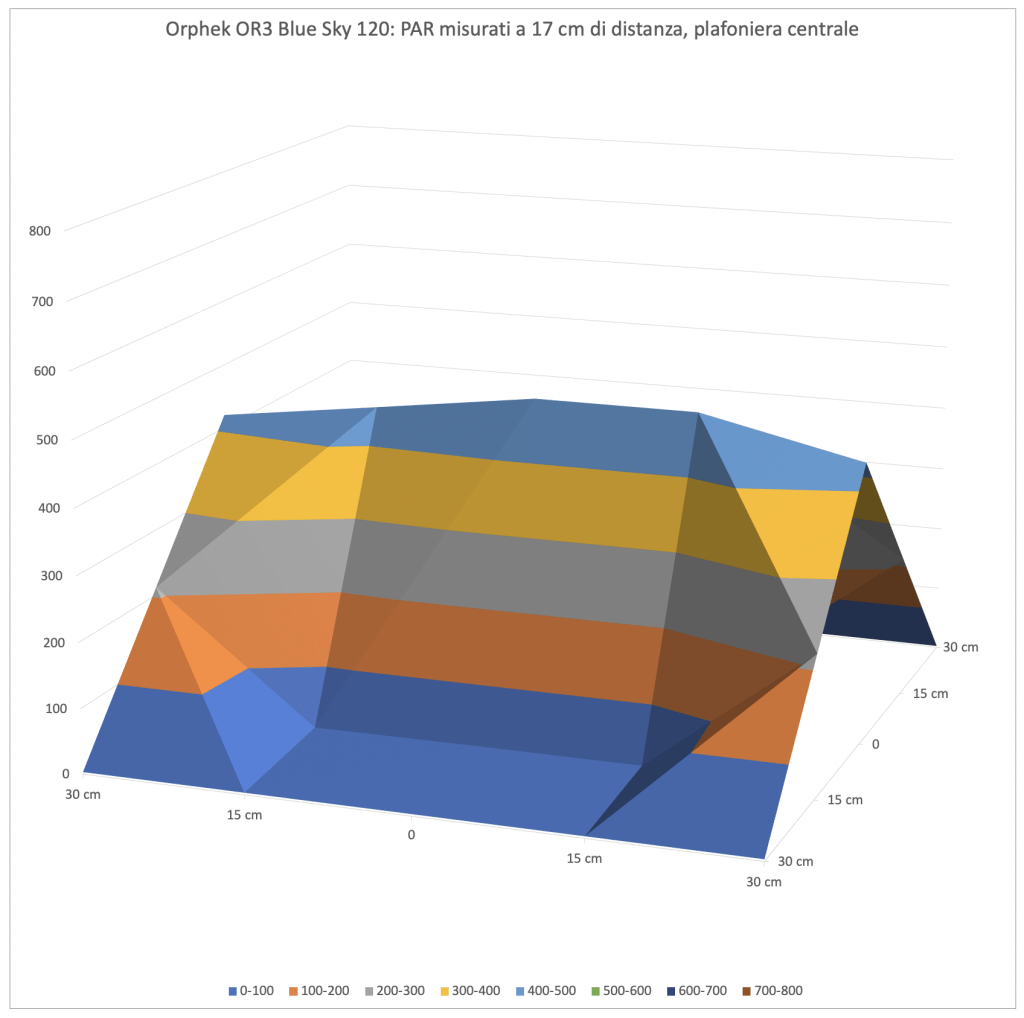
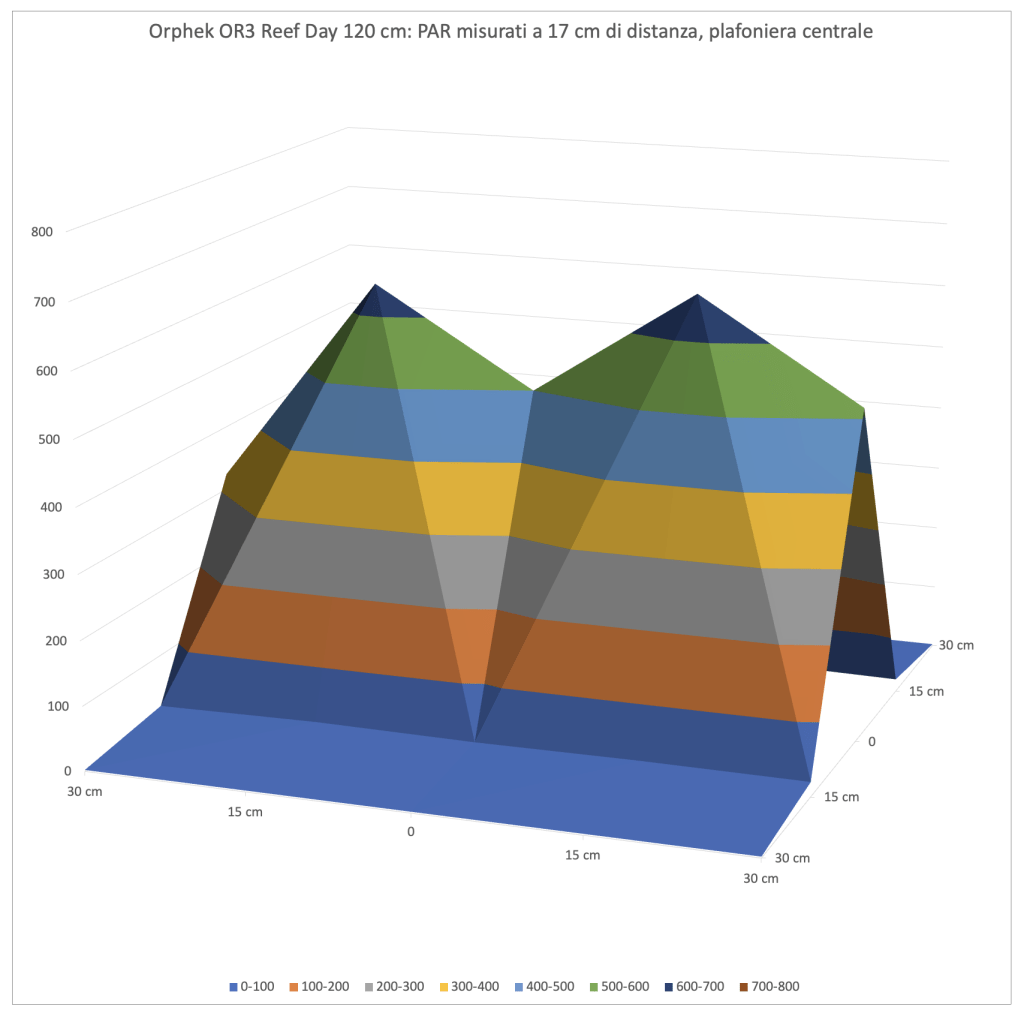
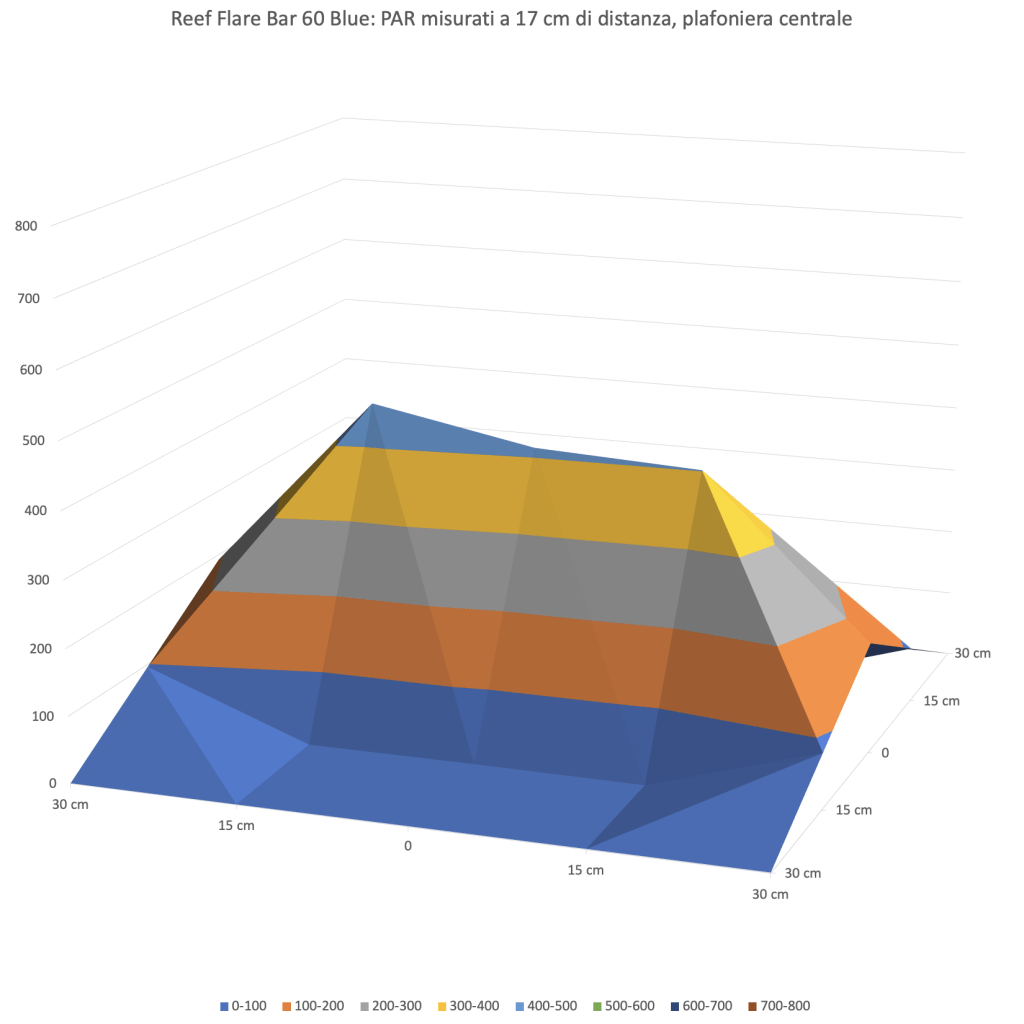
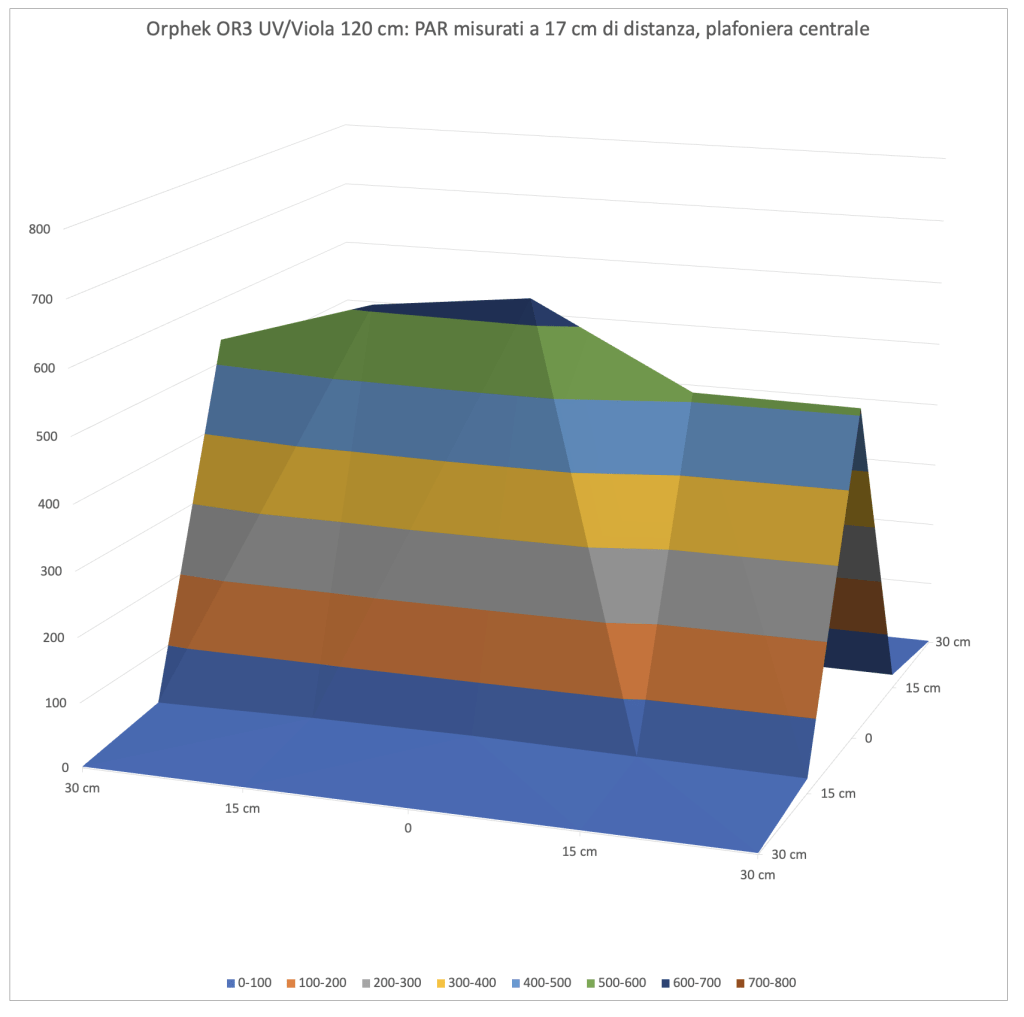
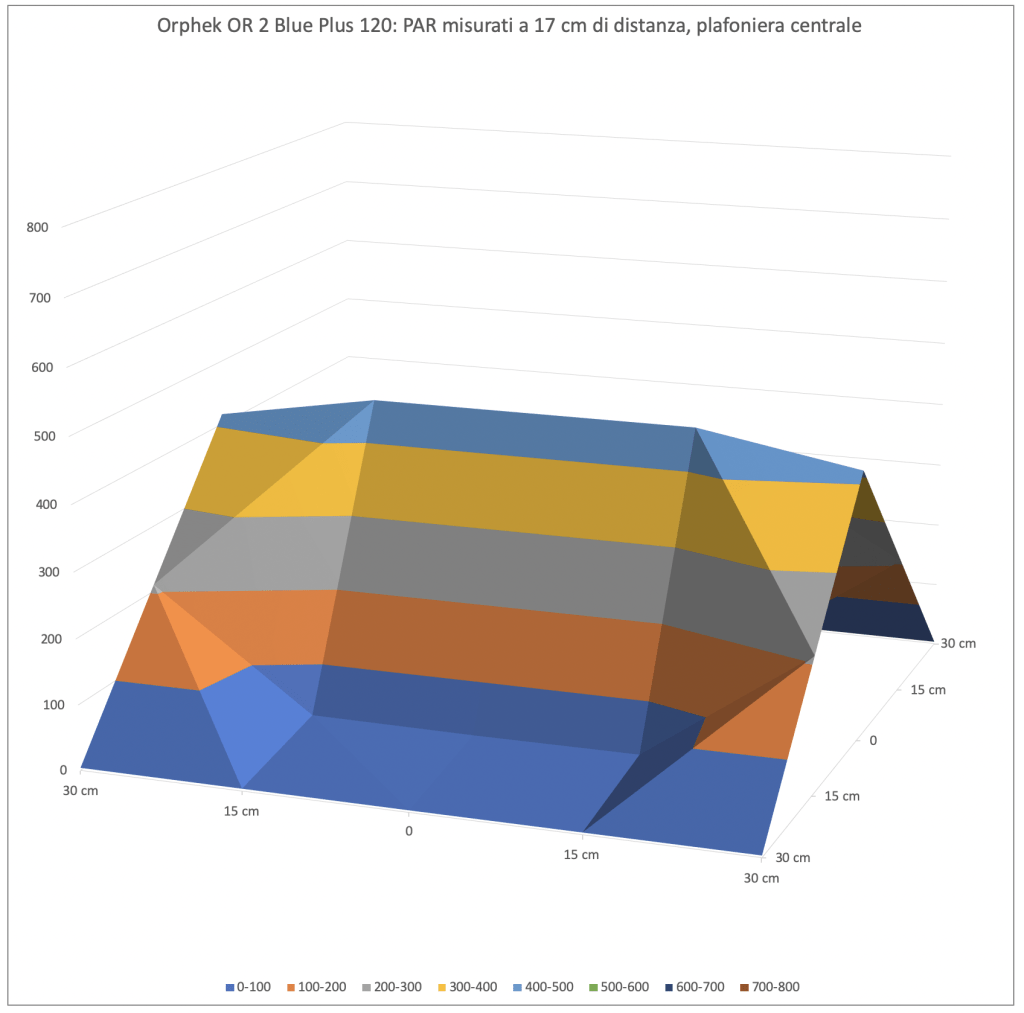
As we expected at this wavelength, the PAR value is the highest of all other ceiling lights at wide spectrum. The difference between the old OR2 is incredible, and remarkable between the Reef Flare S of Reef Factory, though it is only 60 cm long so the decrease of PAR on the sides is normal.
PAR measurement from 37 cm of distance
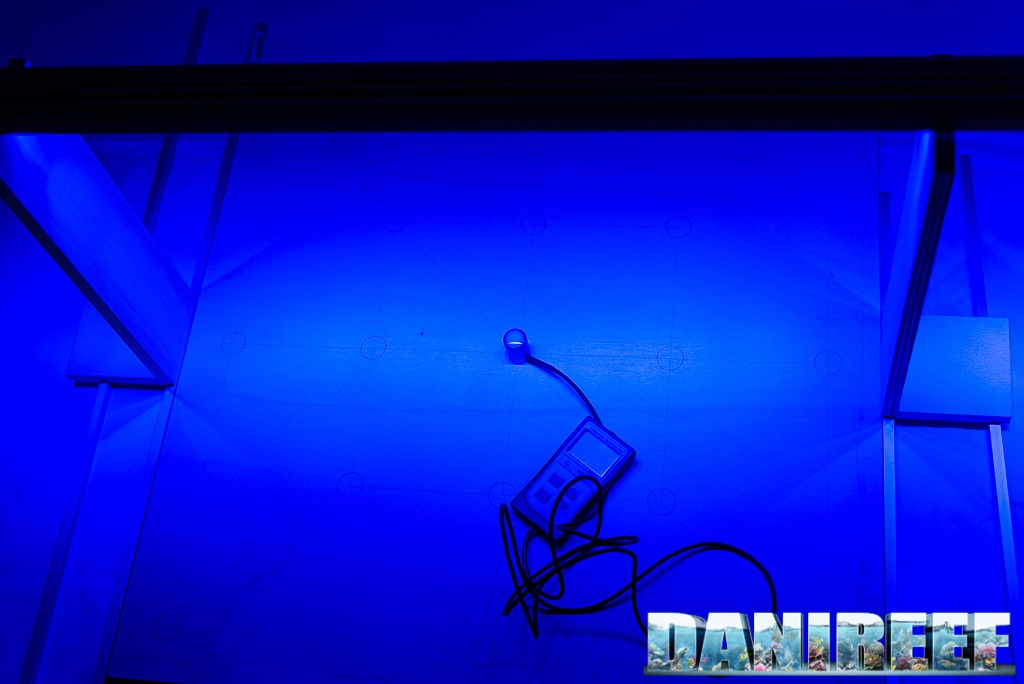
This is the condition of the test. Below there are the chart and the device, above the bar (in this case it was a OR3 Blue Sky) placed on the spacers.
Here the collected values:
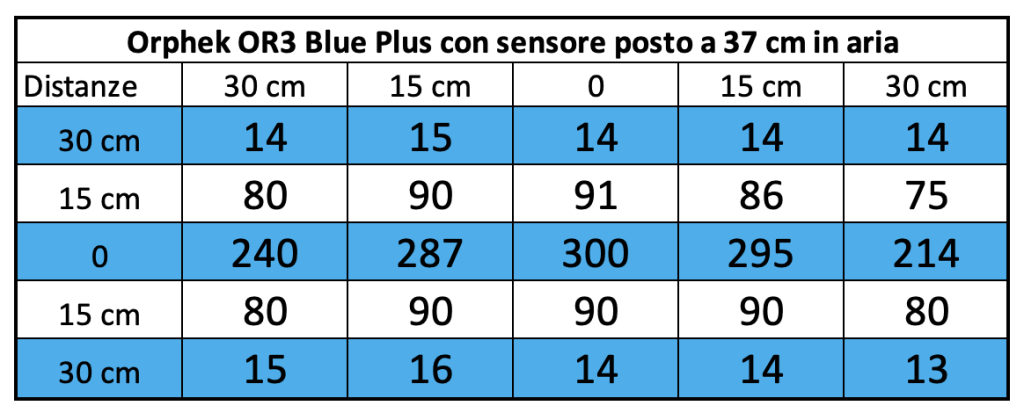
And here is the corresponding chart. In order to maintain uniformity we use the same scale for ceiling lights of the same class, that means they’re similar for power and type.
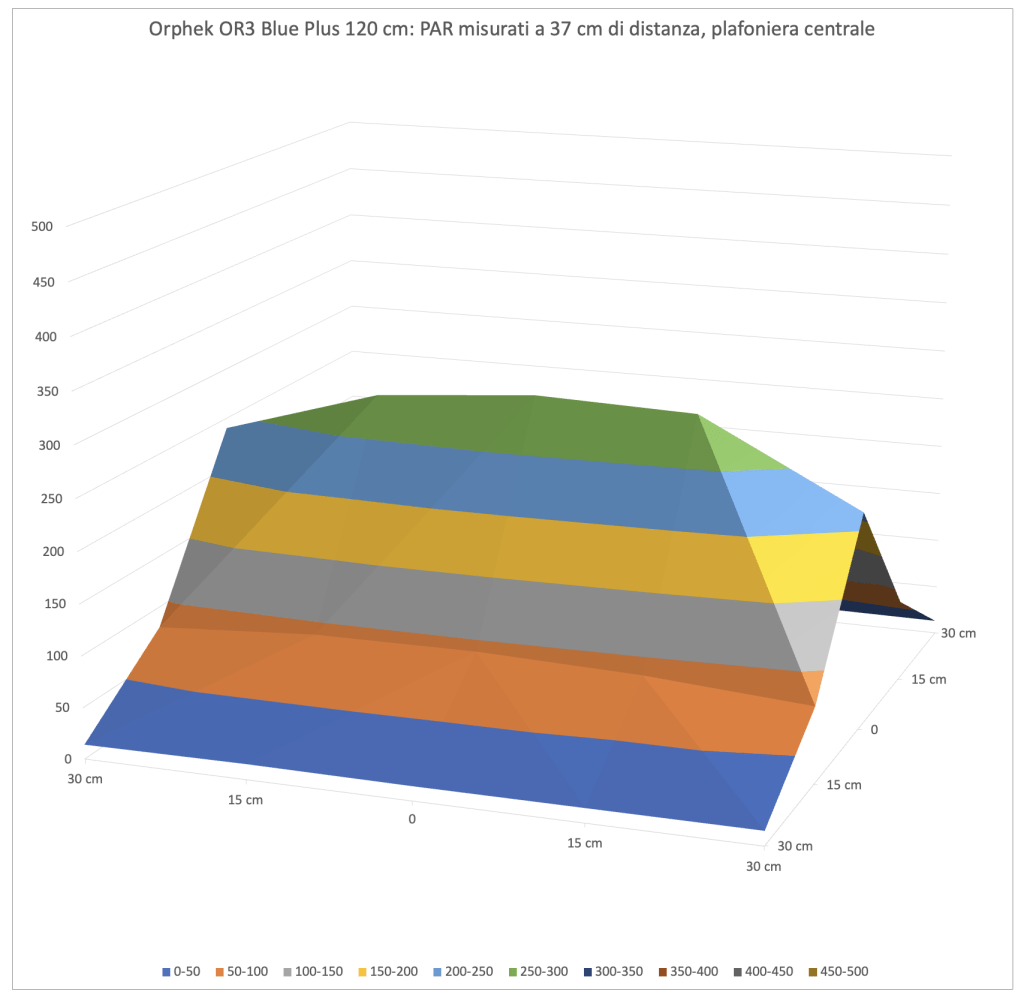
A bigger space between ceiling lights and sensor decreases the difference between PAR in the middle and on the sides. The light spreads wide, but the value in the middle decreases from 680 to 300 μmol m-2 s-1, taken in the brighter points.
It stands out that the covering is more complete and linear. It still keeps this small offset on the right.
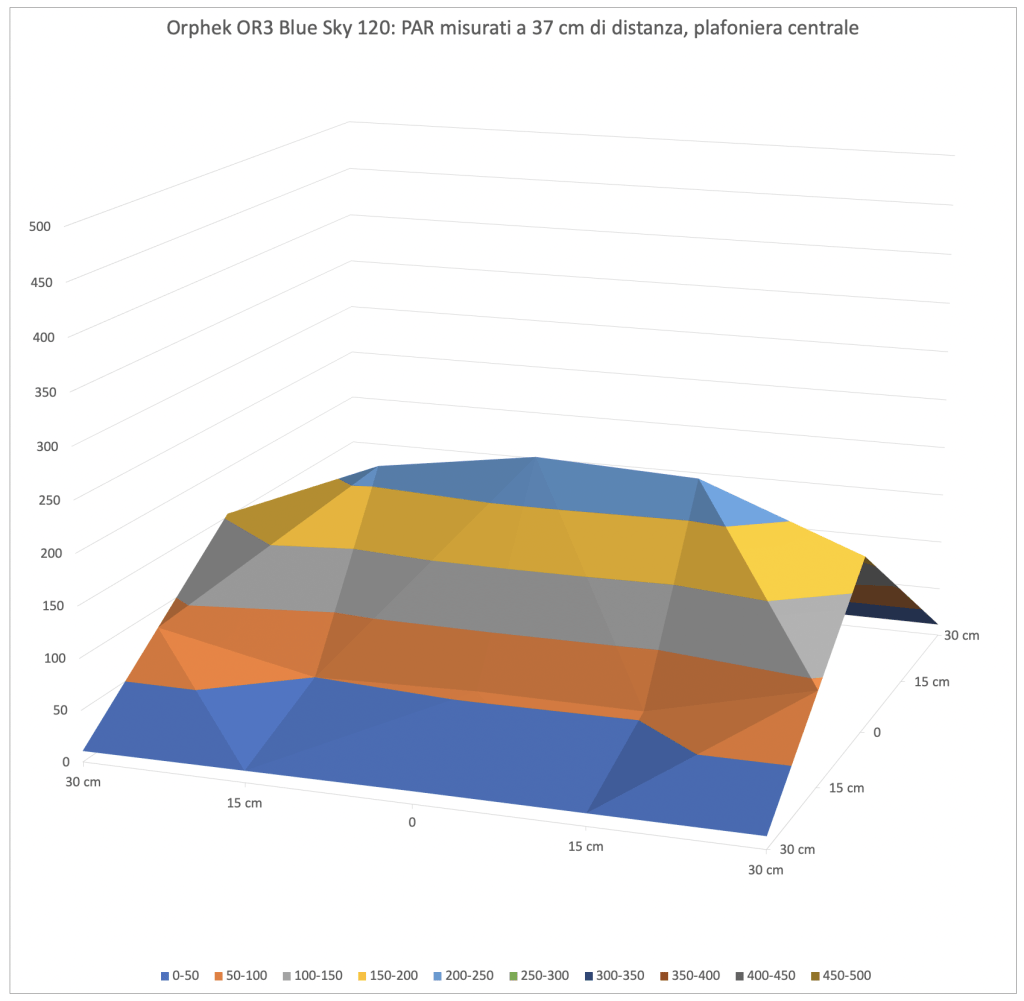
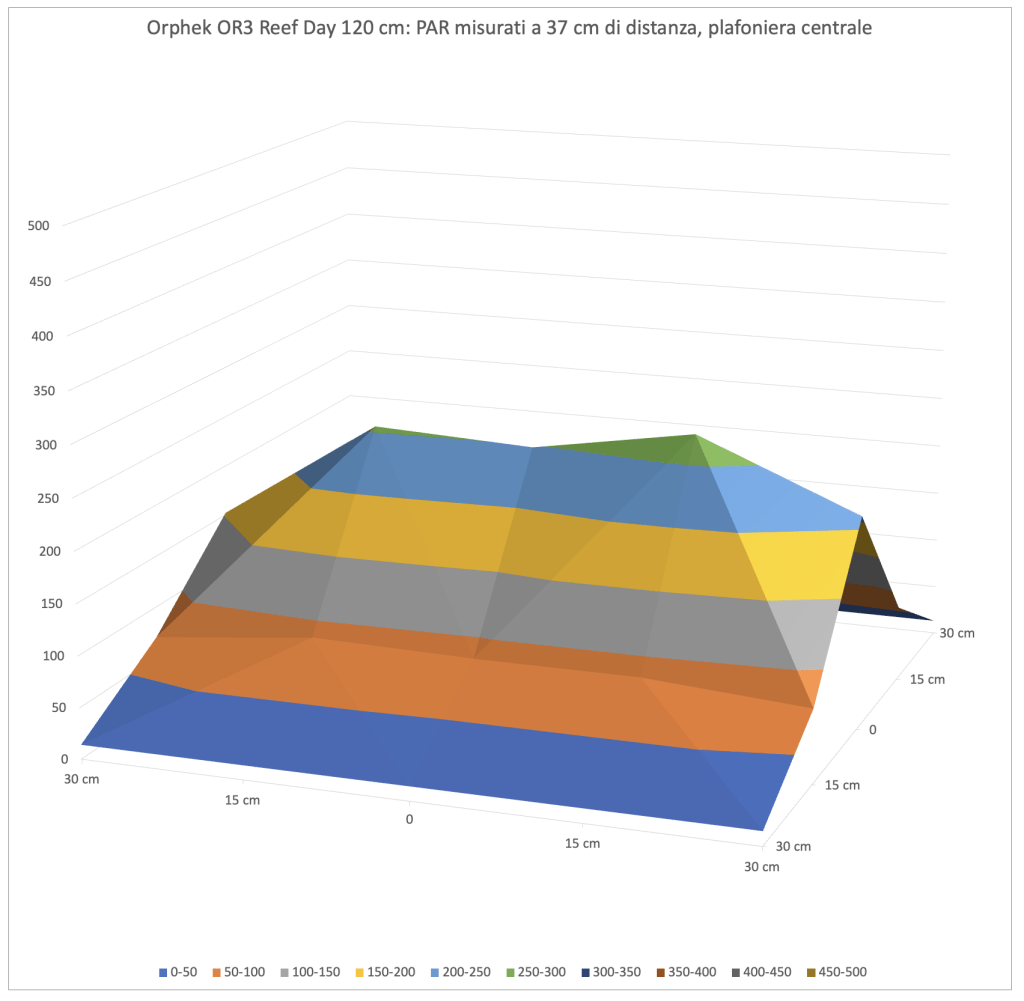
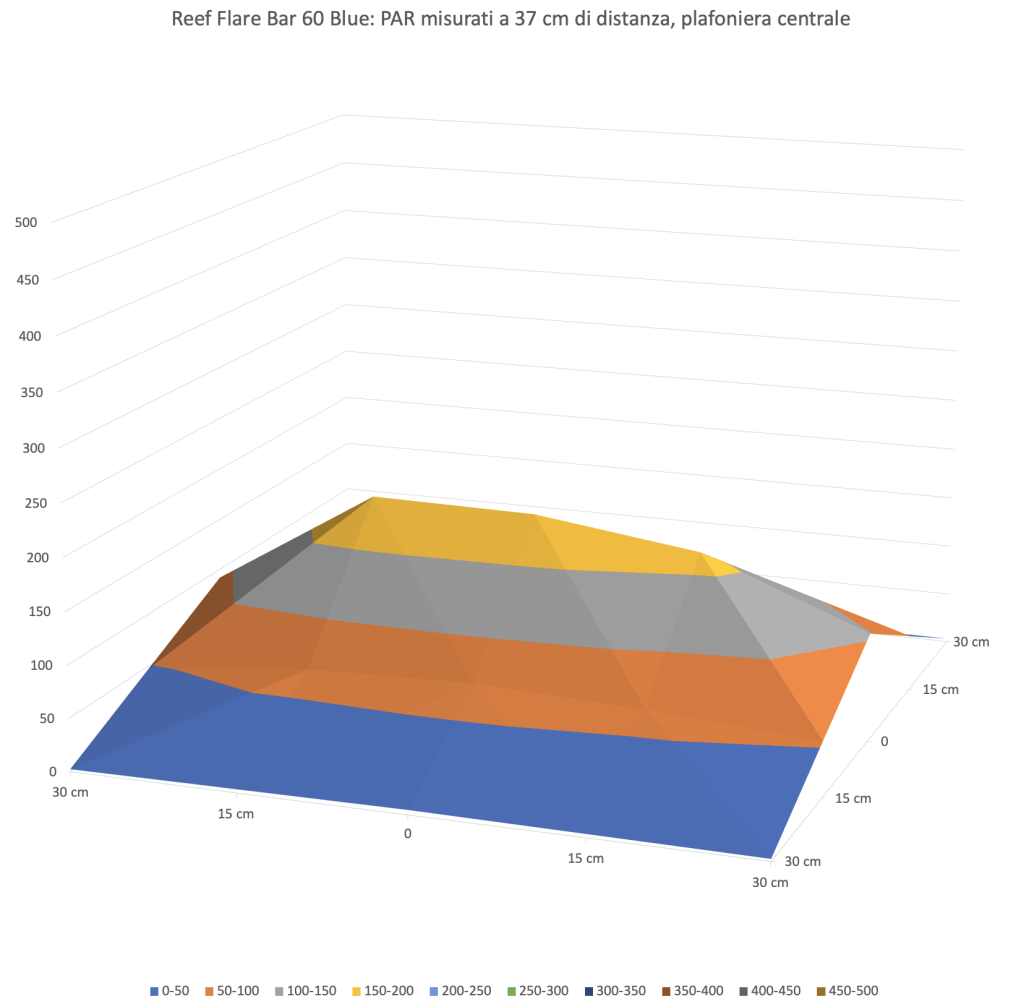
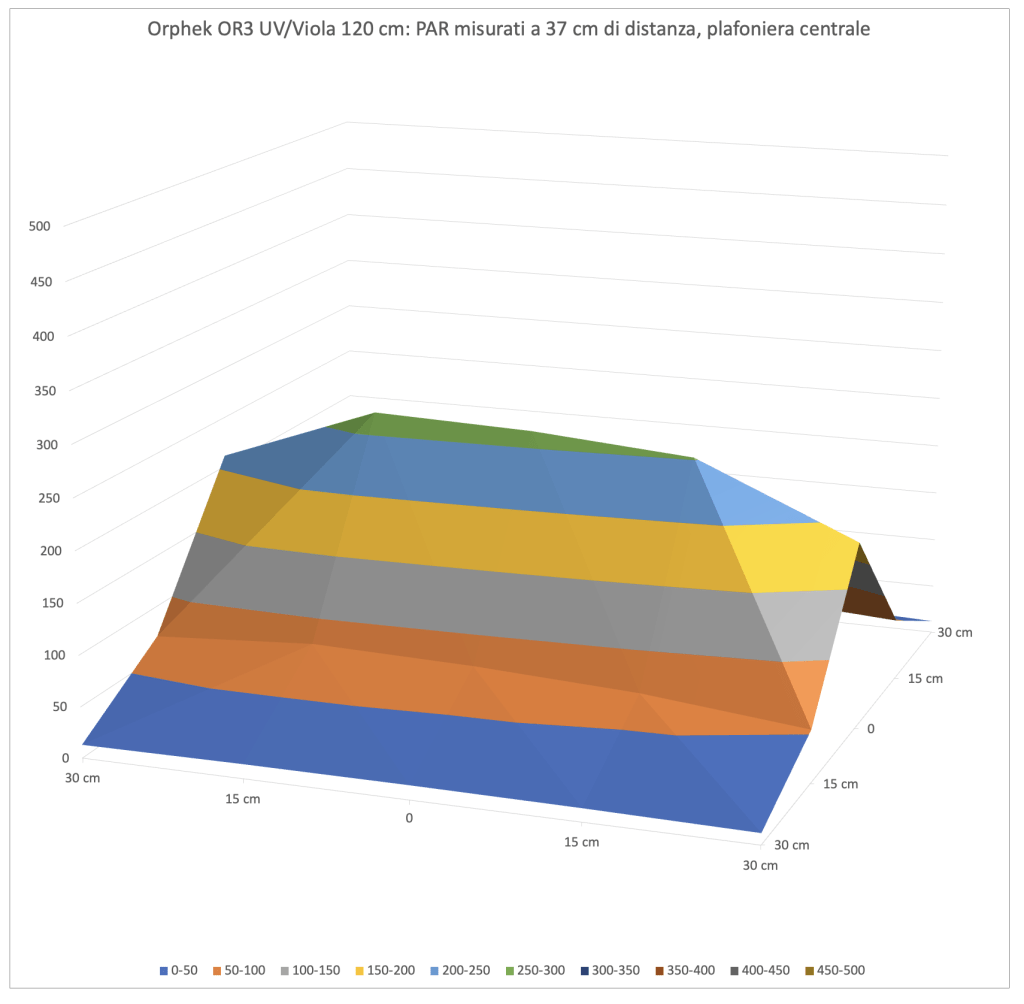
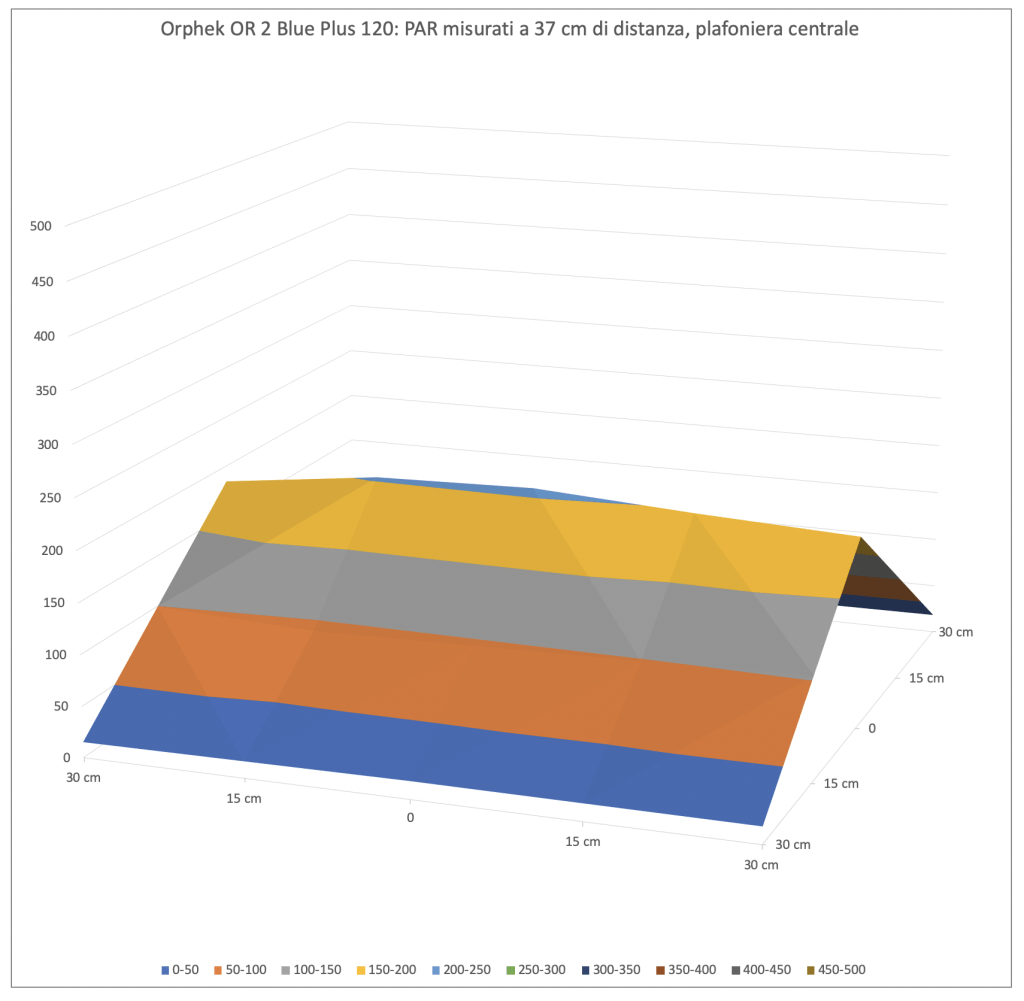
In this case the PAR value is higher than any other LED bar. Much higher than the old OR2.
PAR measurement from 57 cm of distance
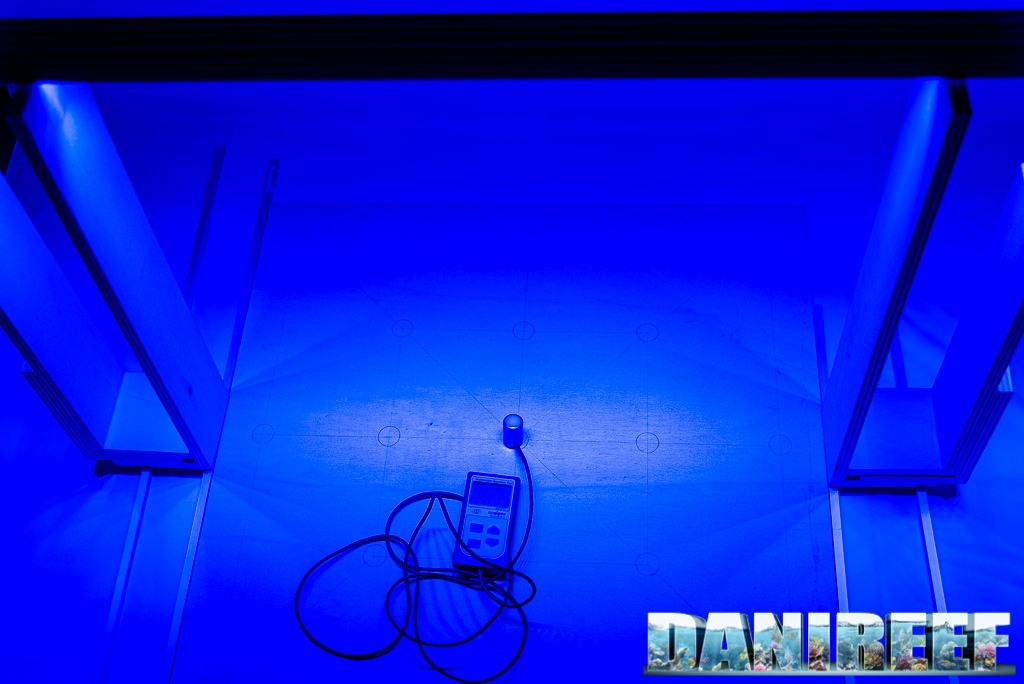
This is the condition of the test. Below is the chart, from this distance the device is very visible, and the bar (in this case it was a OR3 Blue Sky) is placed on the spacers. Even visually the illuminated area is wider, so the specific power per cm decreases.
Here are the collected values:
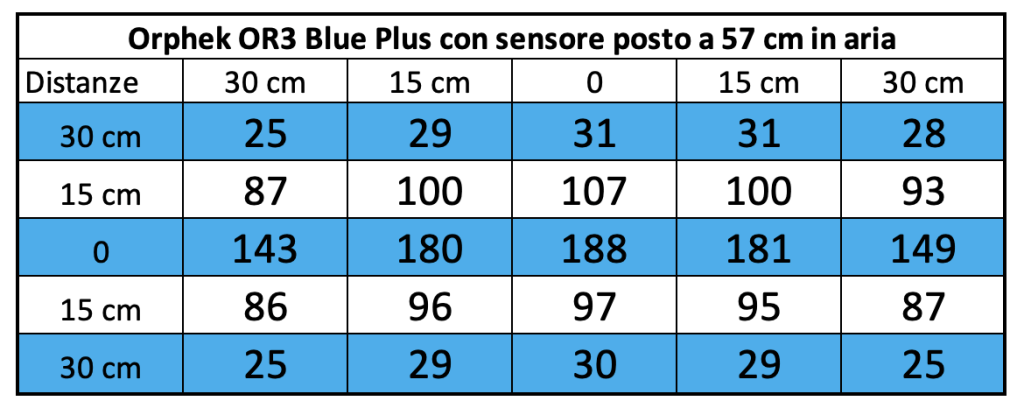
And that’s the corresponding chart.
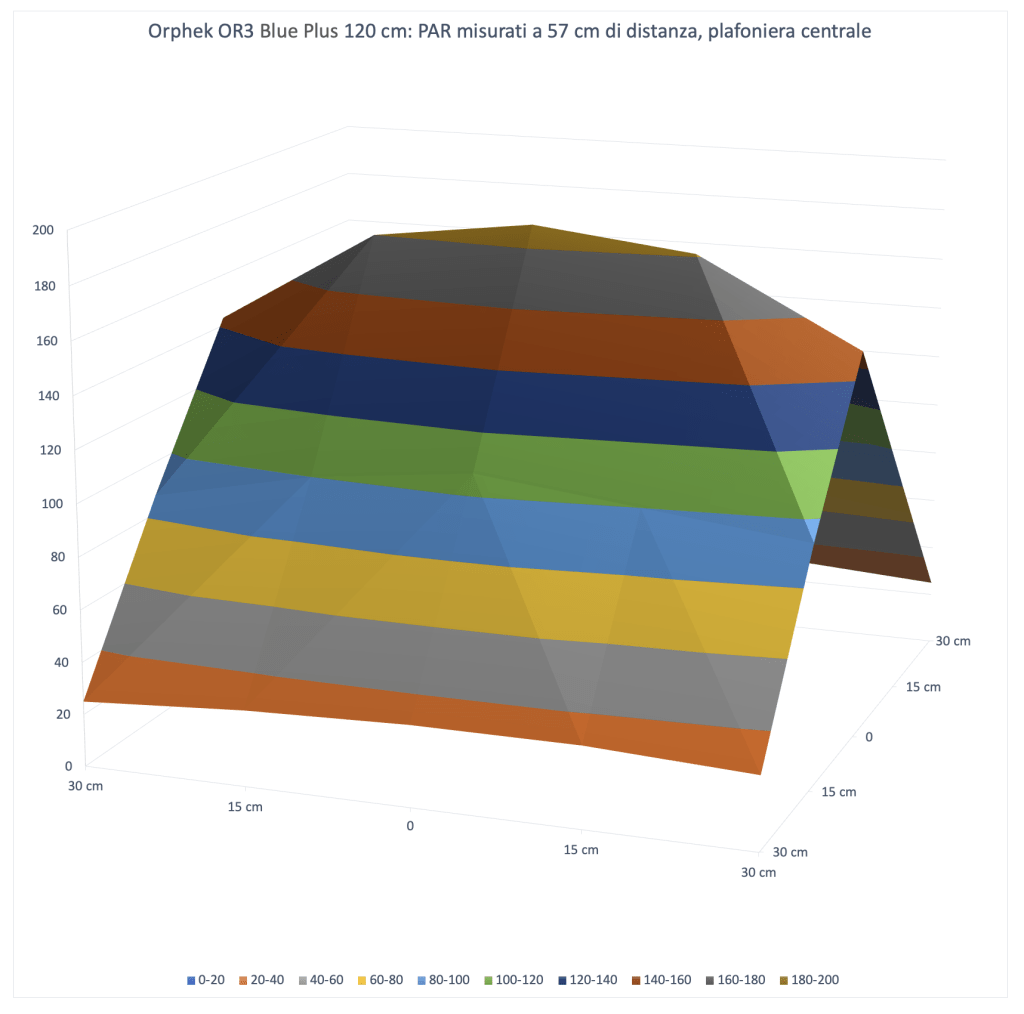
Increasing the space even more between ceiling light and sensor, the spatial distribution is still very uniform, with a small longitudinal drop that we expected. The uniformity is absolutely perfect. The value at the middle decreases again from 680 to 300 to 188 μmol m-2 s-1.
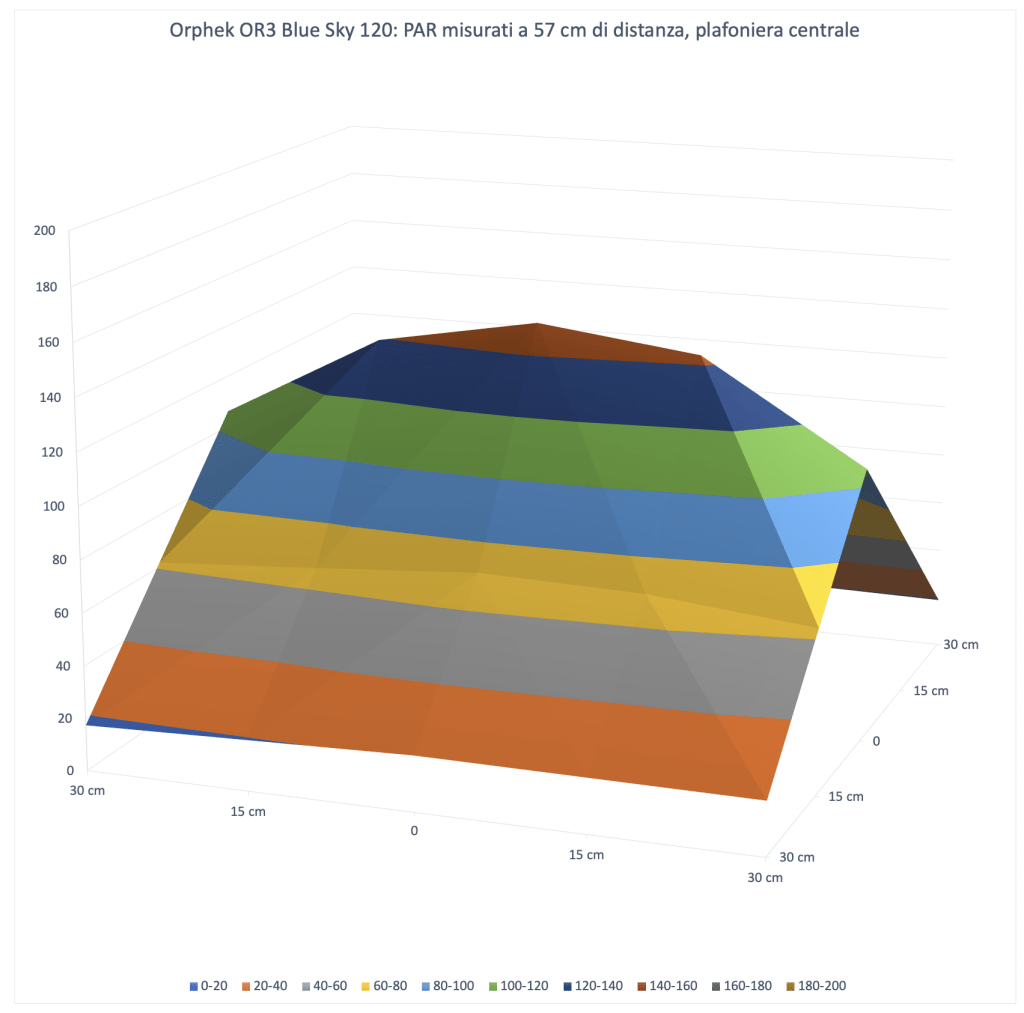
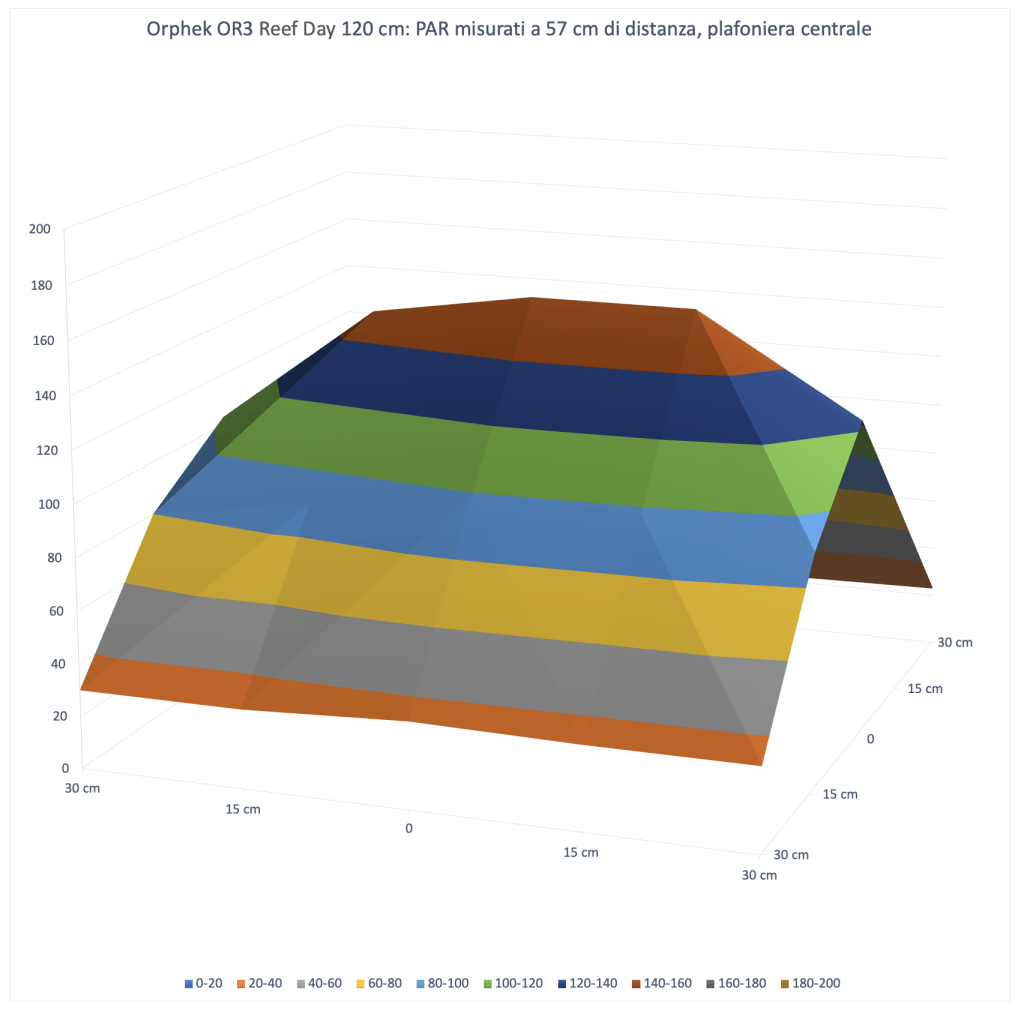
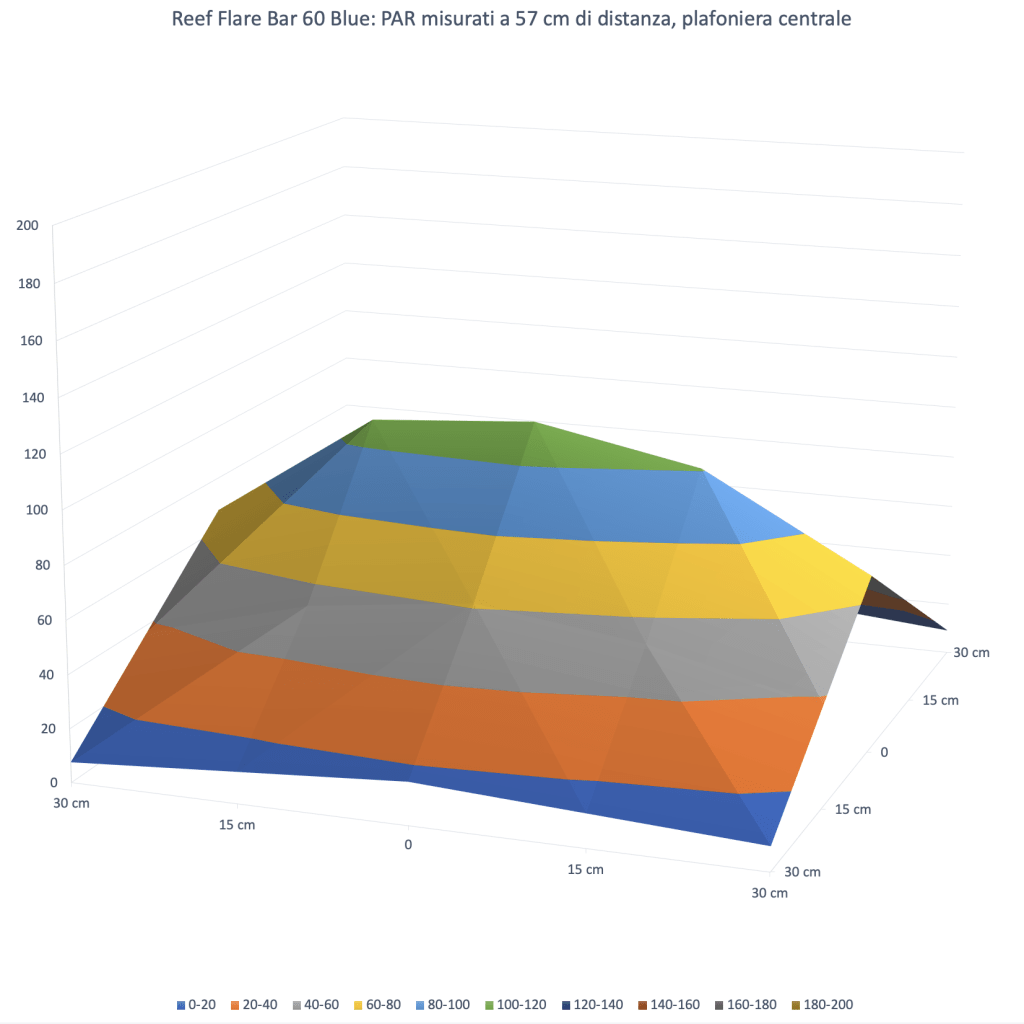
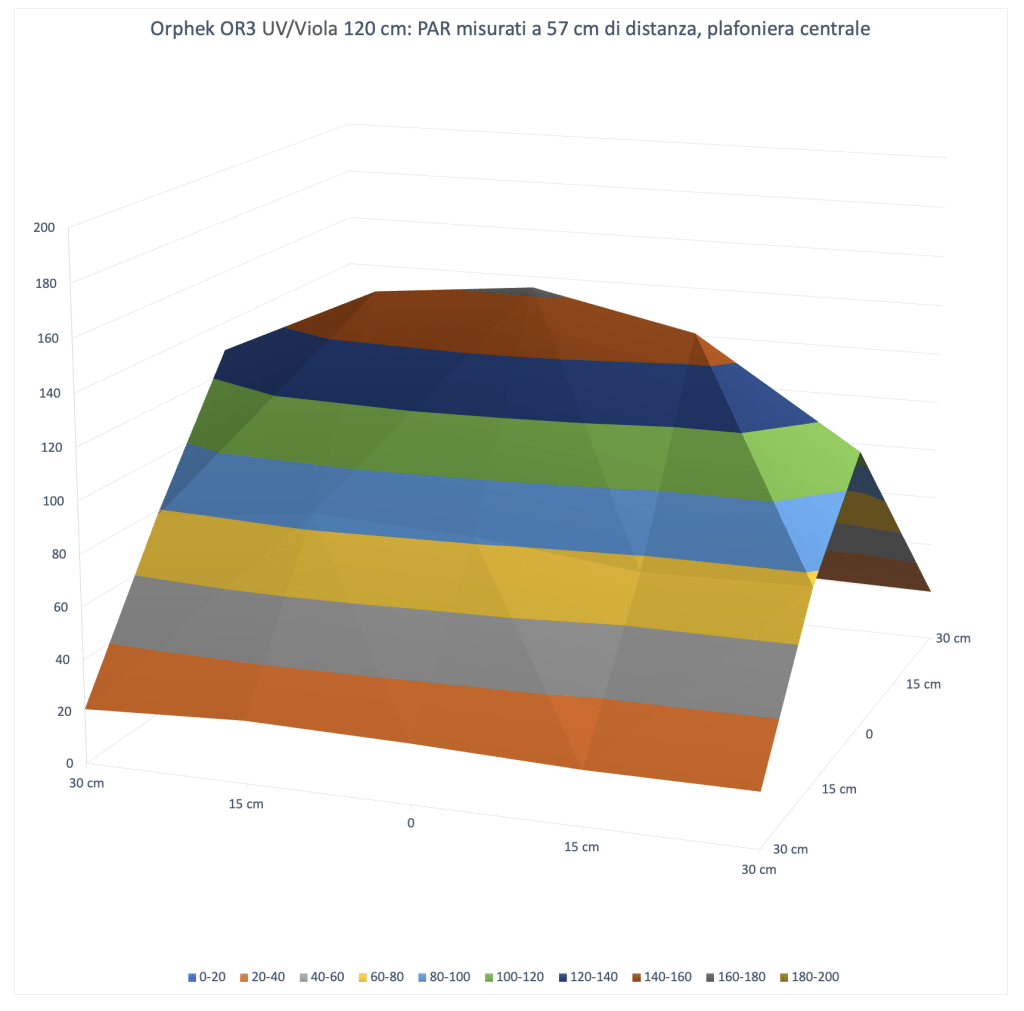
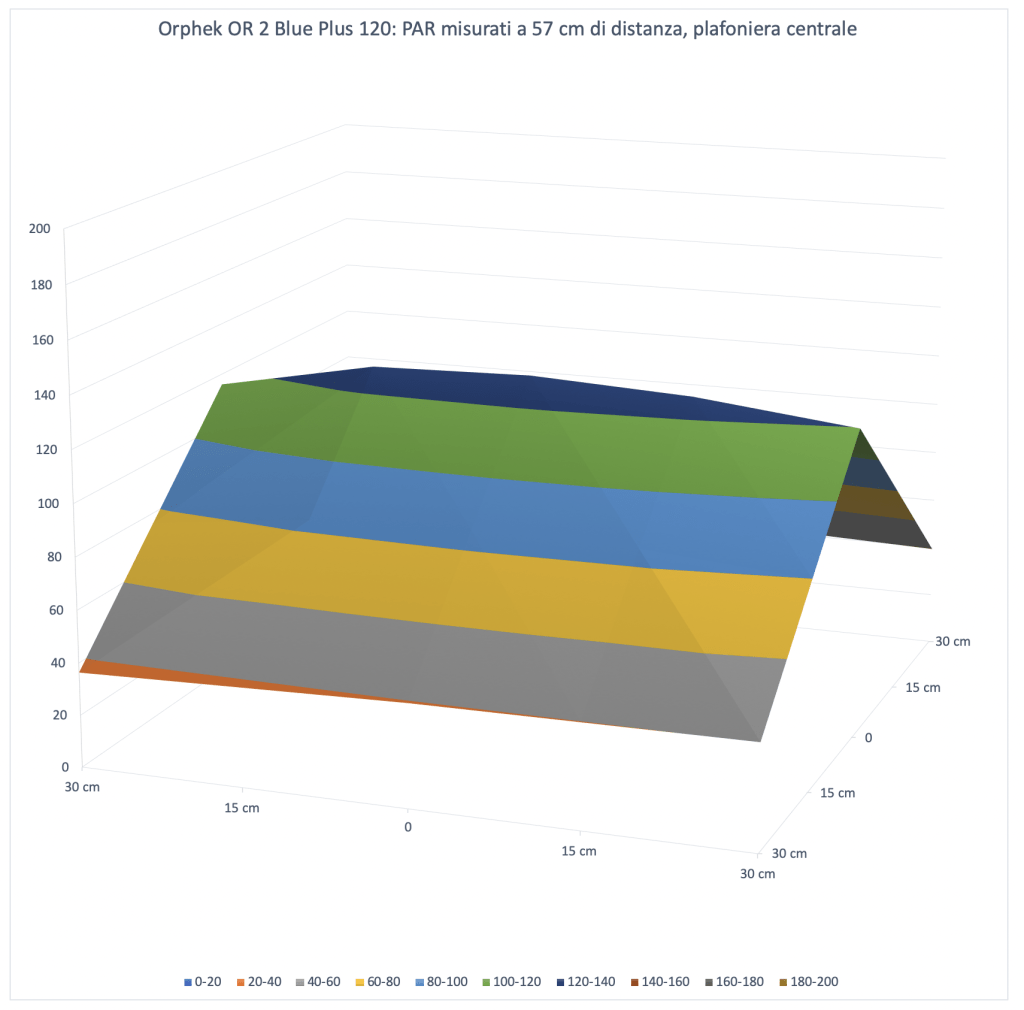
Even at 57 cm the OR3 Blue Plus expresses the higher number of PAR. Many steps higher than the others, especially the old OR2.
The PAR in the middle in the different configurations
Let’s continue with our technical measurements. We can see how, in a chart, the PAR collected in the middle decreases in the three different distances of the tests.
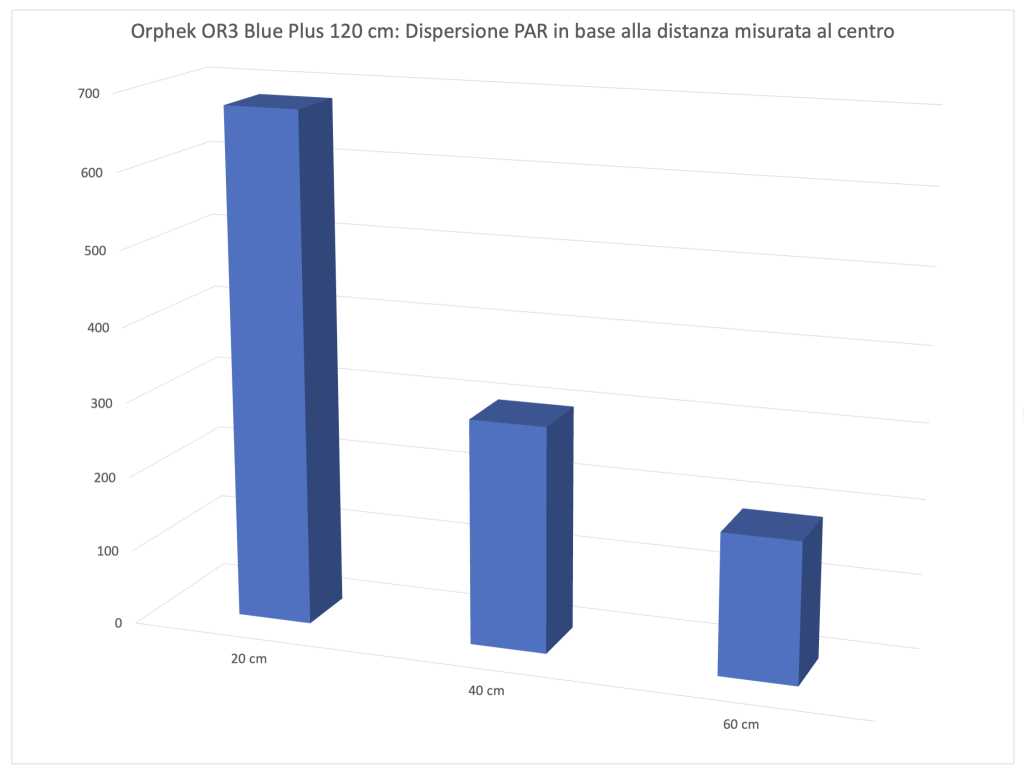
Energy variation of the Orphek OR2 Blue Plus LED bars depending on the distances
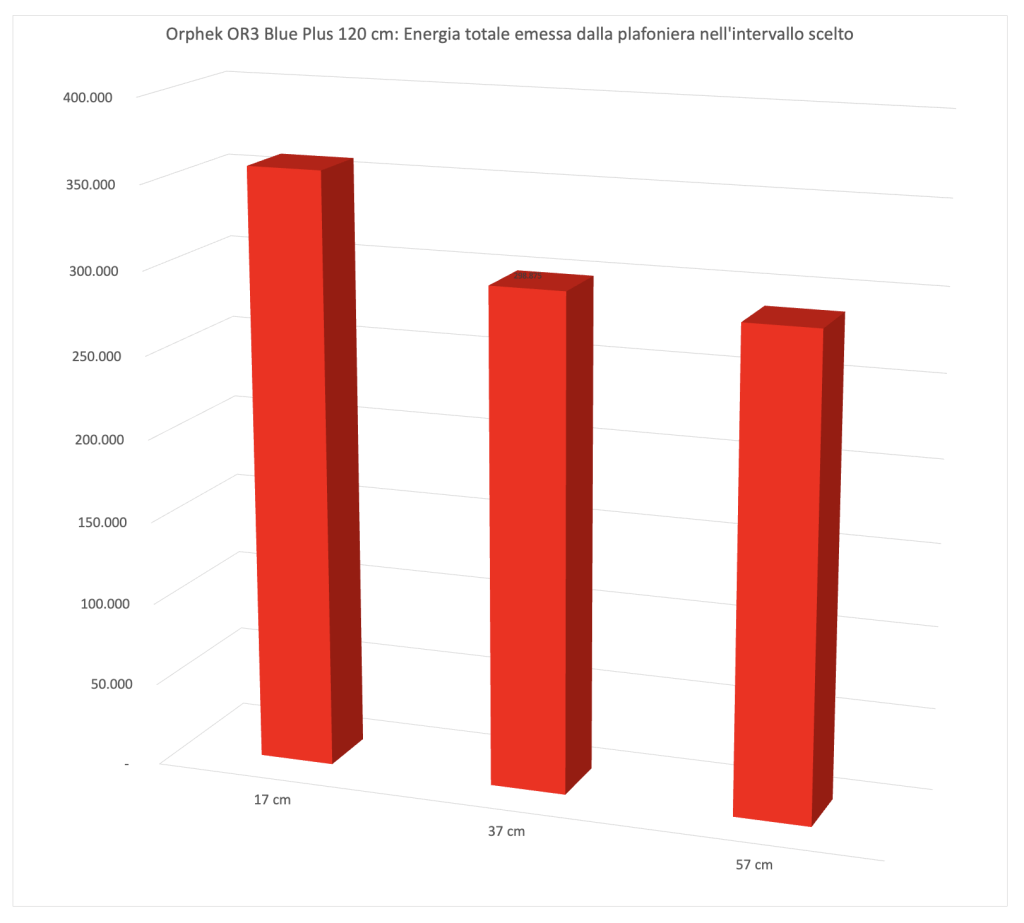
This is the most significant and most comparable data: the energy variation. We calculated the volumes of the three surfaces previously seen. It’s obvious that moving away from the ceiling light the PAR decreases, also because the light illuminates a wider space. We try to consider all the light energy in this square of 60 cm under the bar. And it’s clear that the three values of 358.000, 299.000 and 289.000 assume a different connotation compared to the values in the middle. When the first ones decrease because the distances increase, the subtended area, which is the energy, decreases very slowly. The three areas are similar. Little energy is lost over the area.
Considering the values of the three curves you can see that on the sides there’s more light at 57 cm than at 37. It’s also remarkable that the energy at 37 cm and 57 cm is basically the same.
How to value these numbers in aquarium?
This is a good question. At first we thought that we could transport these values to the aquarium tout-court. Then we filled the aquarium, inserted the probe and re-did the measurements. We fazed but, as we have already said in elsewhere, we’re going to talk about this in another article. Basically, while at 20 cm the result is practically the same, as we progressed, thanks to the glass and the water itself reflecting the light, we found double the values measured in air. Obviously this isn’t a detail that can be standardized, so we think that our method of calculation is the most correct, and the best for the comparison of coverings of different ceiling lights.
Power consumption
The Orphek OR3 Blue Plus ceiling light has a declared power consumption of 60 watts. Considering that at 17 cm the ceiling light has a maximum of 680 μmol m-2 s-1, we can say, in perspective, that it will have a peak value of 11,33 μmol m-2 s-1 w-1 (PAR per watt). This value is hardly comparable with other ceiling lights because it remains constant throughout the length.
The comparison with other ceiling lights on the market
This data was collected with the Quantum Meter MQ-510/MQ-511 by Apogee.
Considering the first ceiling lights we managed to test we can do an interesting comparison about their produced energy:
| Energy | Cost | Power consumption | Energy/€ | Energy/w | |
| ASF Proten LED Reef Blue at 17 cm | 138.000 | 130 | 27,80 | 1.060 | 4.956 |
| ASF Proten LED Reef Blue at 37 cm | 93.000 | 130 | 27,80 | 718 | 3.357 |
| ASF Proten LED Reef Blue at 57 cm | 60.000 | 130 | 27,80 | 464 | 2.166 |
| Orphek OR2 Blue Plus 120 cm at 17 cm | 323.000 | 180 | 54,69 | 1.794 | 5.906 |
| Orphek OR2 Blue Plus 120 cm at 37 cm | 291.000 | 180 | 54,69 | 1.616 | 5.321 |
| Orphek OR2 Blue Plus 120 cm at 57 cm | 259.000 | 180 | 54,69 | 1.438 | 4.736 |
| Orphek OR3 Blue Plus 120 cm at 17 cm | 358.000 | 270 | 60 | 1.327 | 5.973 |
| Orphek OR3 Blue Plus 120 cm at 37 cm | 299.000 | 270 | 60 | 1.107 | 4.981 |
| Orphek OR3 Blue Plus 120 cm at 57 cm | 288.000 | 270 | 60 | 1.070 | 4.814 |
| Orphek OR3 Blue Sky at 17 cm | 318.000 | 200 | 62,04 | 1.590 | 5.129 |
| Orphek OR3 Blue Sky at 37 cm | 221.000 | 200 | 62,04 | 1.103 | 3.449 |
| Orphek OR3 Blue Sky at 57 cm | 206.000 | 200 | 62,04 | 1.027 | 3.211 |
| Orphek OR2 Reef Day Plus 120 cm at 17 cm | 255.000 | 180 | 54,69 | 1.418 | 4.667 |
| Orphek OR2 Reef Day Plus 120 cm at 37 cm | 233.000 | 180 | 54,69 | 1.292 | 4.252 |
| Orphek OR2 Reef Day Plus 120 cm at 57 cm | 225.000 | 180 | 54,69 | 1.251 | 4.117 |
| Orphek OR3 Reef Day Plus 120 cm at 17 cm | 294.000 | 270 | 60 | 1.087 | 4.892 |
| Orphek OR3 Reef Day Plus 120 cm at 37 cm | 261.000 | 270 | 60 | 965 | 4.343 |
| Orphek OR3 Reef Day Plus 120 cm at 57 cm | 253.000 | 270 | 60 | 937 | 4.218 |
| Orphek OR3 UV/Violet 120 cm at 17 cm (italian) | 303.000 | 300 | 60 | 1.012 | 5.058 |
| Orphek OR3 UV/Violet 120 cm at 37 cm | 252.000 | 300 | 60 | 840 | 4.200 |
| Orphek OR3 UV/Violet 120 cm at 57 cm | 235.000 | 300 | 60 | 785 | 3.922 |
| Reef Flare Bar Blue S at 17 cm | 202.000 | 220 | 24,34 | 918 | 8.299 |
| Reef Flare Bar Blue S at 37 cm | 177.000 | 220 | 24,34 | 804 | 7.272 |
| Reef Flare Bar Blue S at 57 cm | 155.000 | 220 | 24,34 | 704 | 6.368 |
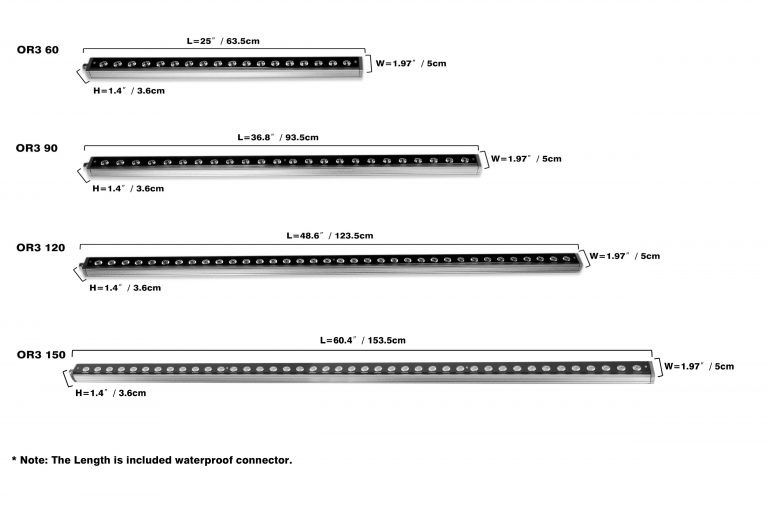
With the OR3 Blue Plus we obtained the highest PAR value we’ve ever measured. At 57 cm of distance it is amazing, more than any other solution, so we want to suggest you be careful when you speak of these wave lengths in aquarium.
Maintenance costs
The Orphek OR3 Blue Plus LED bars cost 270 euro. On Orphek’s website they’re sold for 200 dollars. The price seems different, but it doesn’t. Remember that you have to add taxes and duties to the 200 dollars and they’re about 32% of the total, so the price would be 264 dollars, and the difference of 64 dollars would be paid to shipping courier. It’s true that the change between euro and dollars would make you save some money, but consider that if you purchase the bar in Italy the warranty would last two years, otherwise it would be for one year only. I think that the purchase in Italy is more convenient.
The absorbed power is 60 watts, so the cost/watt ratio is almost 4,5 euro per watt. In order to do a comparison with the other ceiling lights you can refer to this chart:
| Ceiling light | Price | Power consumption | Euro/watt ratio |
| Orphek OR3 Blue Sky | 200 USD | 62 w | 3,2 euro per watt |
| Orphek OR2 Blue Plus | 180 USD | 54.7 w | 3,3 euro per watt |
| Orphek OR2 Reef Day Plus | 180 USD | 54,7 w | 3,3 euro per watt |
| Cetus 2 | 215 € | 60,7 w | 3,5 euro per watt |
| Philips Coralcare 2019 | 749 € | 190 w | 3,9 euro per watt |
| Maxspect Ethereal | 500 € | 126 w | 4,0 euro per watt |
| Orphek OR3 Reef Day Plus | 270 € | 60 w | 4,5 euro per watt |
| ASF Proten LED Reef Blue 90-120 | 130 € | 27,8 w | 4,67 euro per watt |
| Radion XR30w G2 PRO | 790 € | 170 w | 4,7 euro per watt |
| AI Hydra 32 HD | 430 € | 90,5 w | 4,75 euro per watt |
| Radion XR30w G4 PRO | 915 € | 190 w | 4,84 euro per watt |
| OceanLed Sunrise 600 | 870 € | 180 w | 4,8 euro per watt |
| Orphek Atlantik V4 | 1099 € | 226 w | 4,9 euro per watt |
| Radion XR30w G2 | 690 € | 140 w | 4,9 euro per watt |
| Orphek OR3 UV/Violet | 300 € | 60 w | 5 euro per watt |
| Radion XR30w G4 | 760 € | 150 w | 5,1 euro per watt |
| Aqamai LRM | 465 € | 87,5 w | 5,1 euro per watt |
| Zetlight UFO ZE-8000 | 500 € | 91,5 w | 5,5 euro per watt |
| Aqamai LRS | 289 € | 47,6 w | 6,1 euro per watt |
| Reef Flare Bar Blue S | 220 € | 24,34 w | 9 euro per watt |
| CEAB Slide & Led | 2.700 € | 275 w | 9,8 euro per watt |
| Sicce GNC 466 | 1.592 € | 120 w | 13,3 euro per watt |
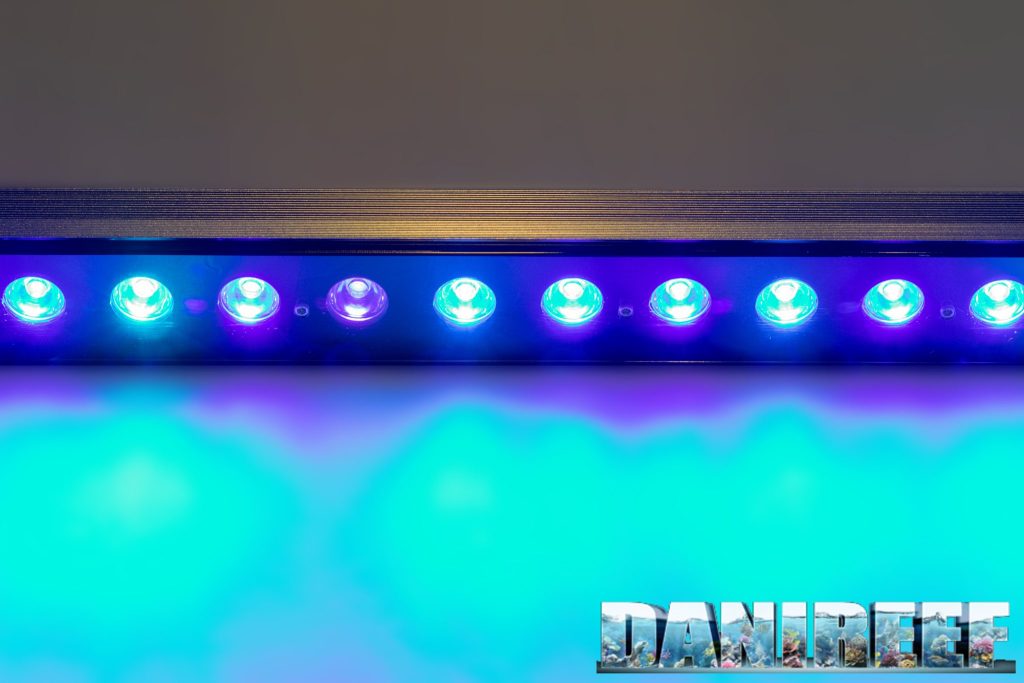
As we have said for the sister OR3 Red Refugium, the LED bar is impeccable, very well built. I really like the extruded borders as well as the refinement. There isn’t programming, which assures a simple modality of use, switched on or off, and you can also assist the ceiling light with other bars to obtain the power you need. You also have to consider the actual PAR you have. In any case if you consider the whole energy you have a more realistic picture. So the bars are perfect for breeding corals, but you have to take the bars you need. Do you need twice the PAR? Use two bars. Do you need four times the PAR? Use four, and so on. What else to ask for from a LED bar? According to me, 4 LED bars should get us 600 PAR in a medium aquarium, and with such a value you can breed Acropora of any complexity.
The cost per watt is average, in line with the previous models, also considering VAT and duties, while the PAR per watt is at a very good level. Better than some Blue ceiling lights of the competitors. What else can we ask from a LED bar?
[Text by Matteo Fusco translated by Agnese Poggi]









0 Comments